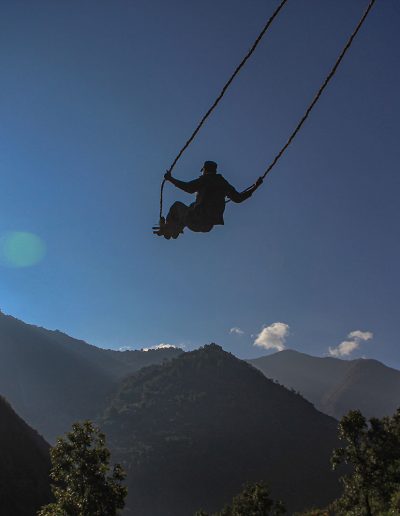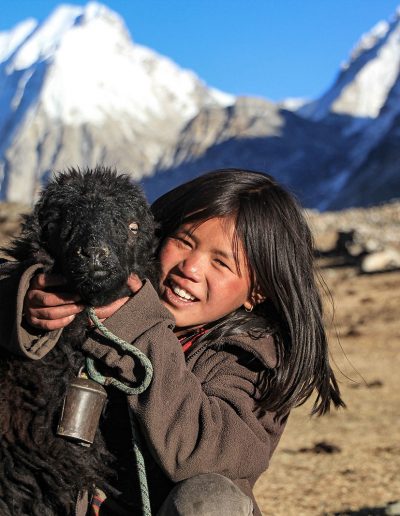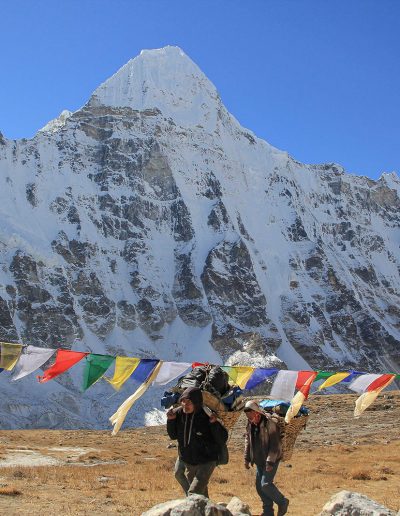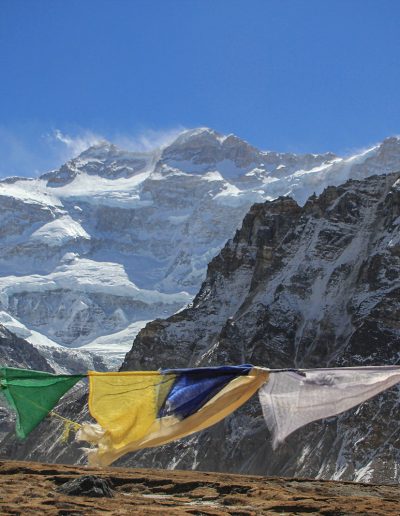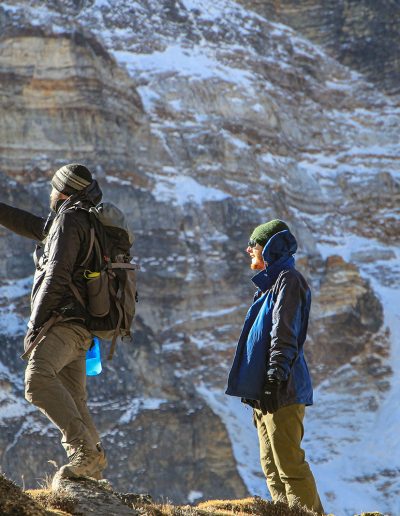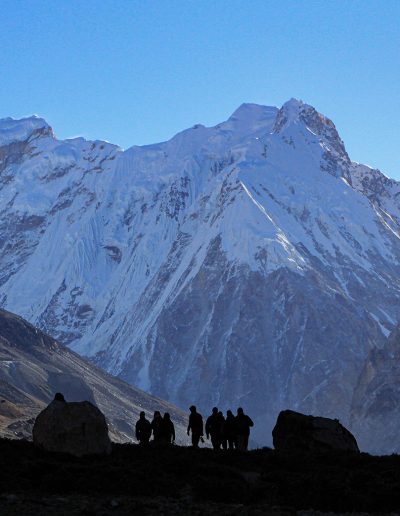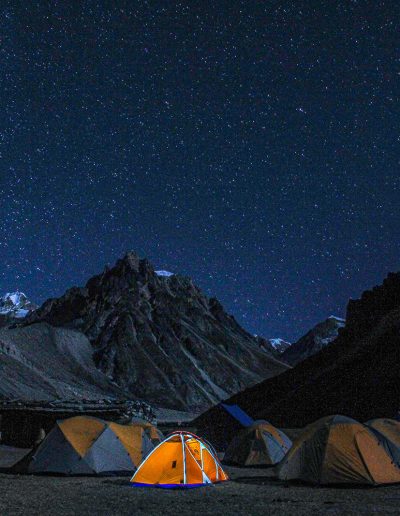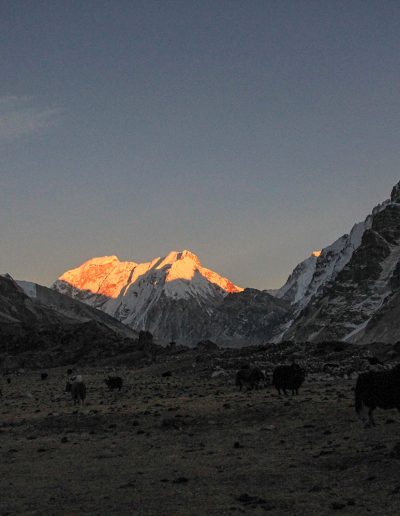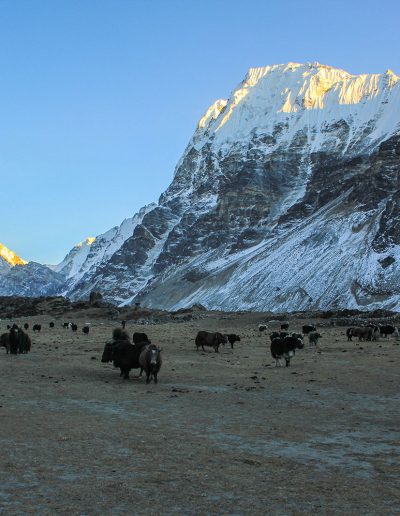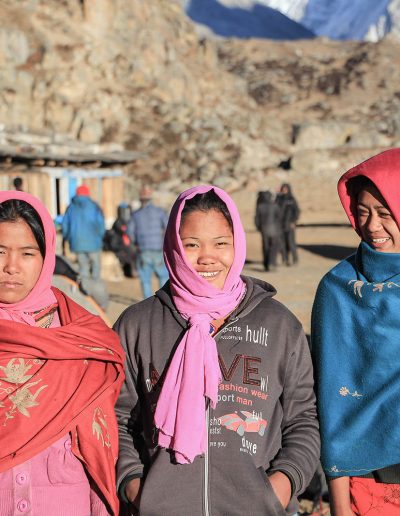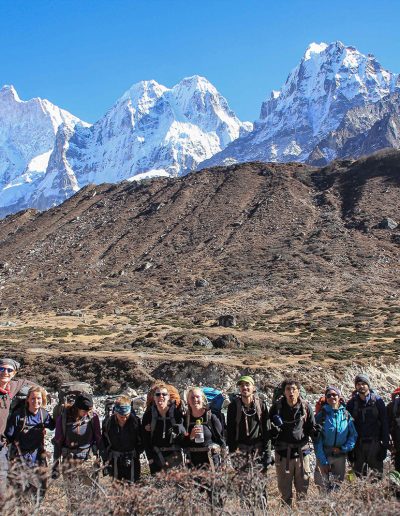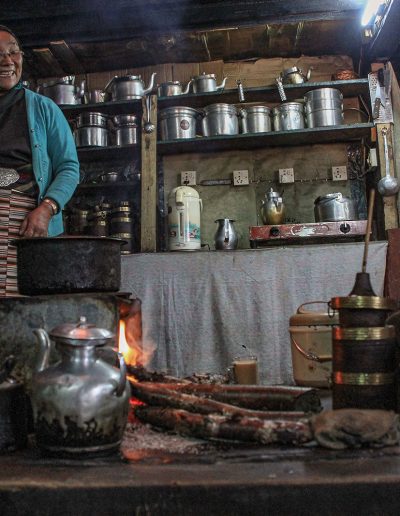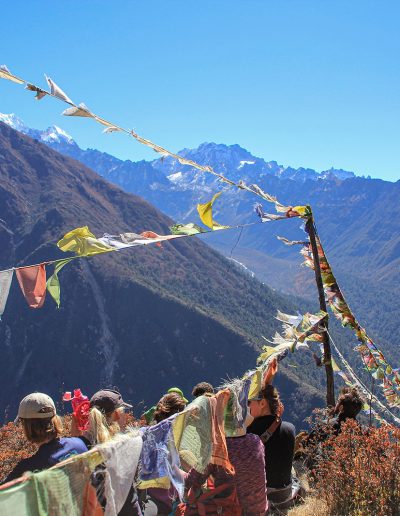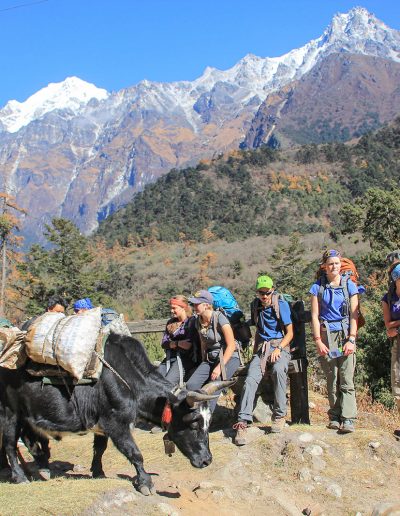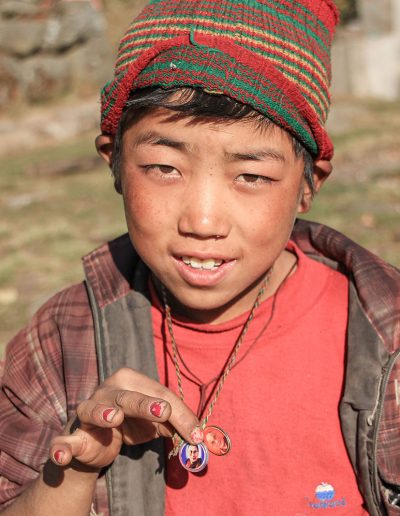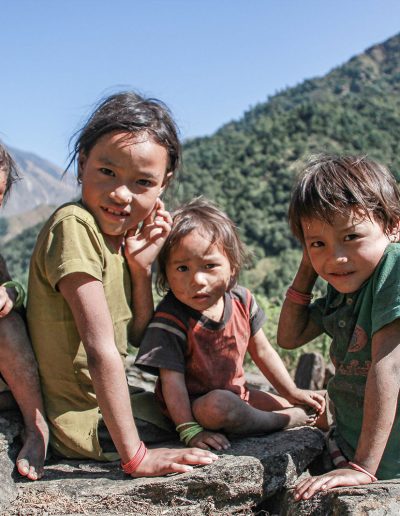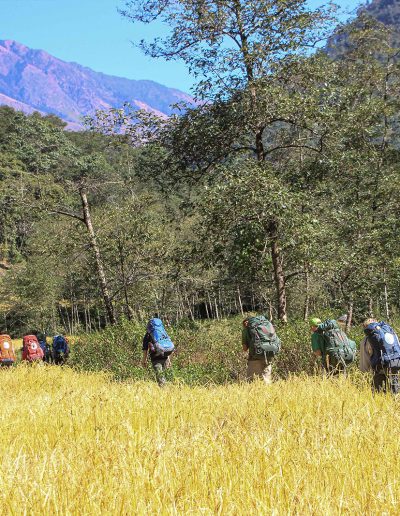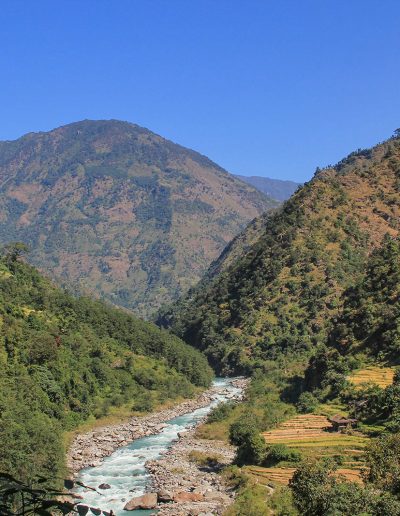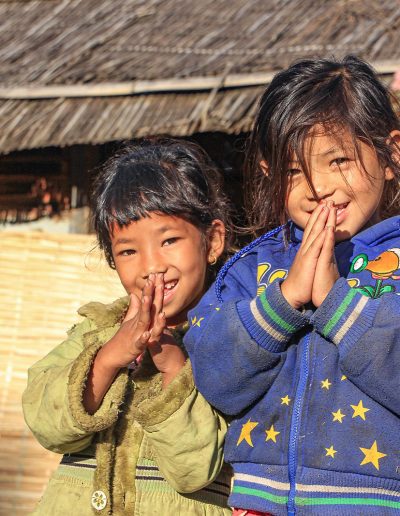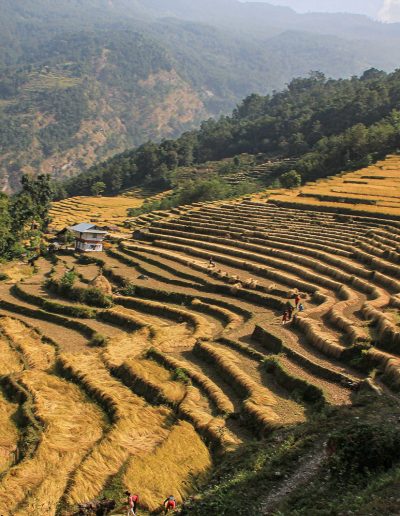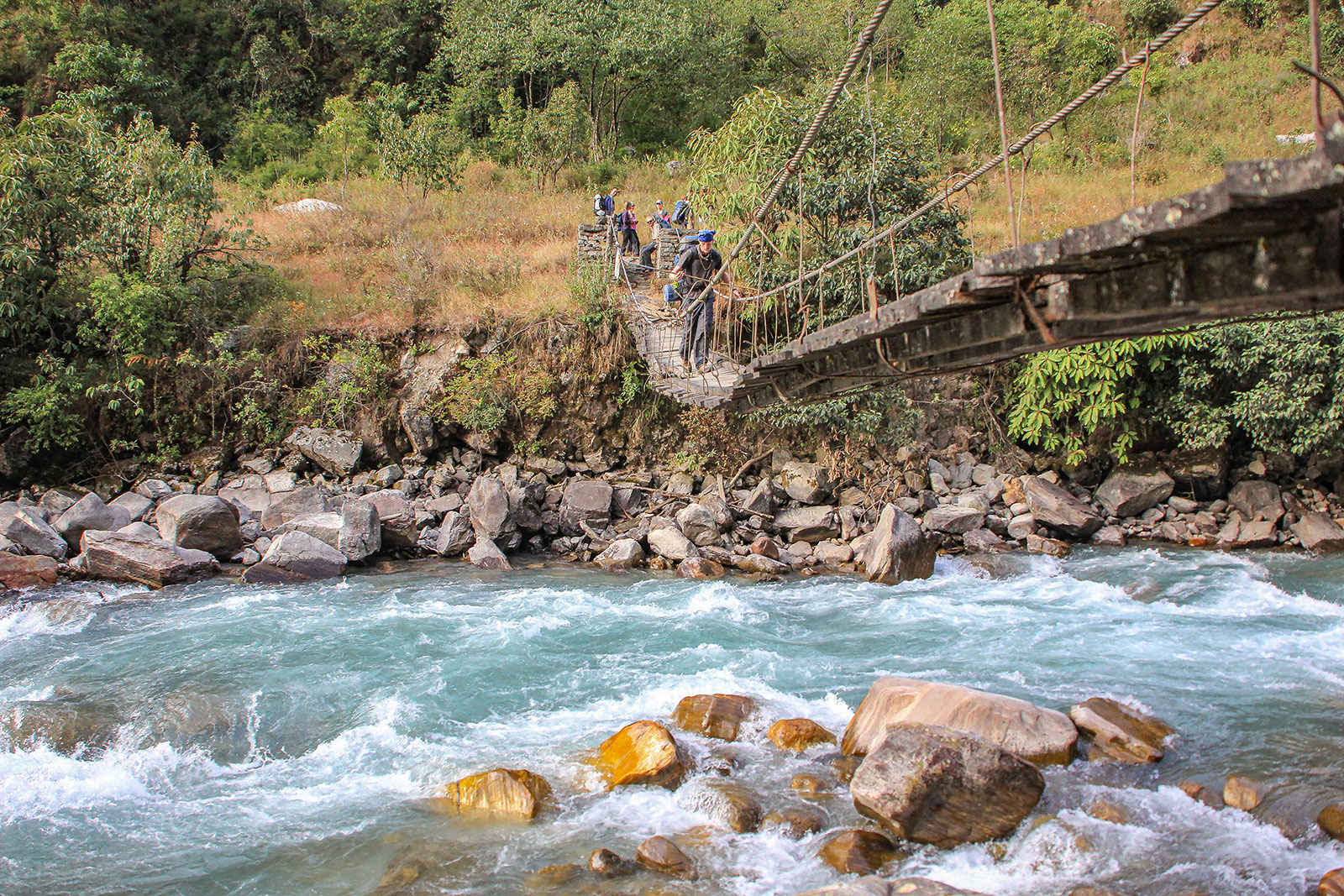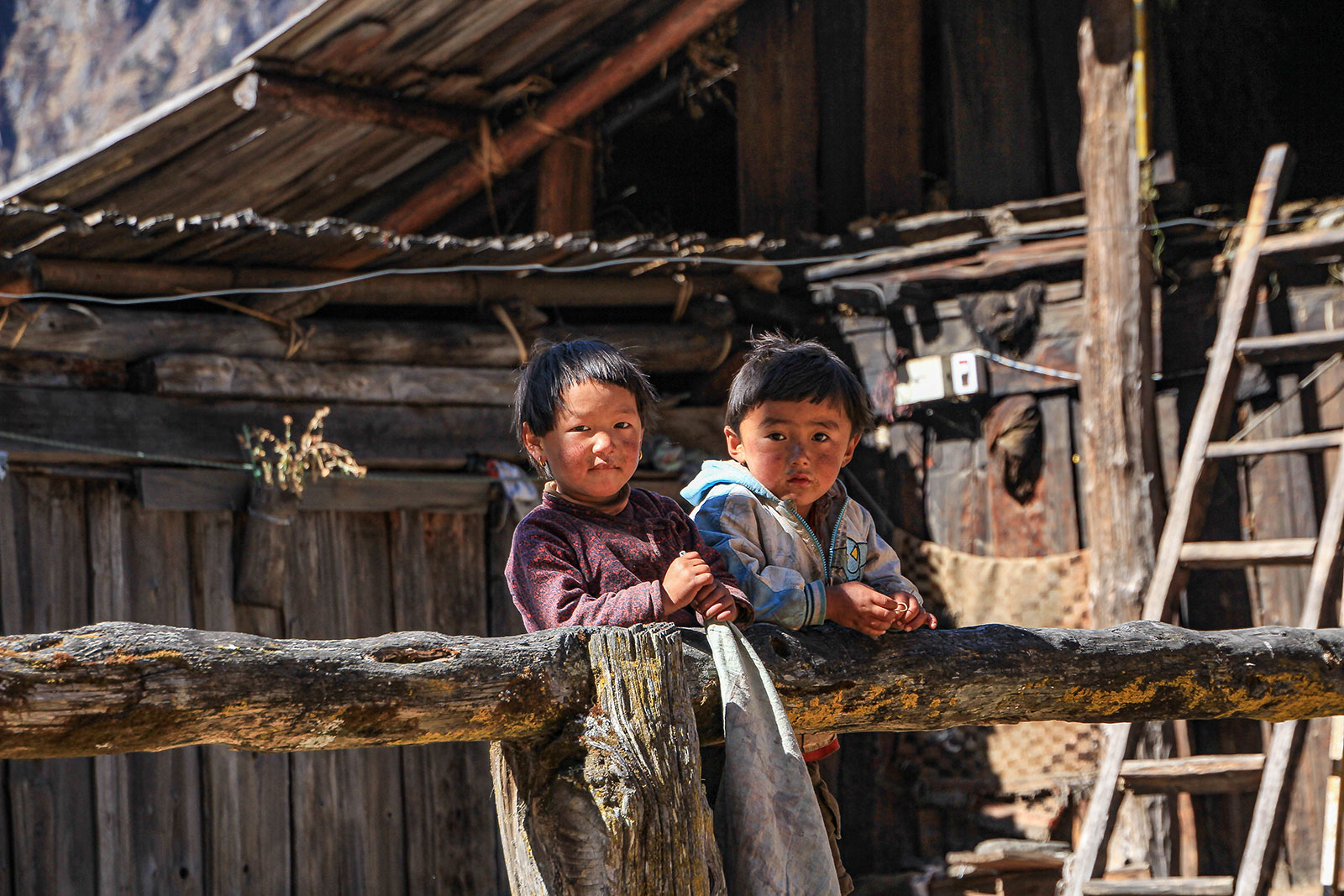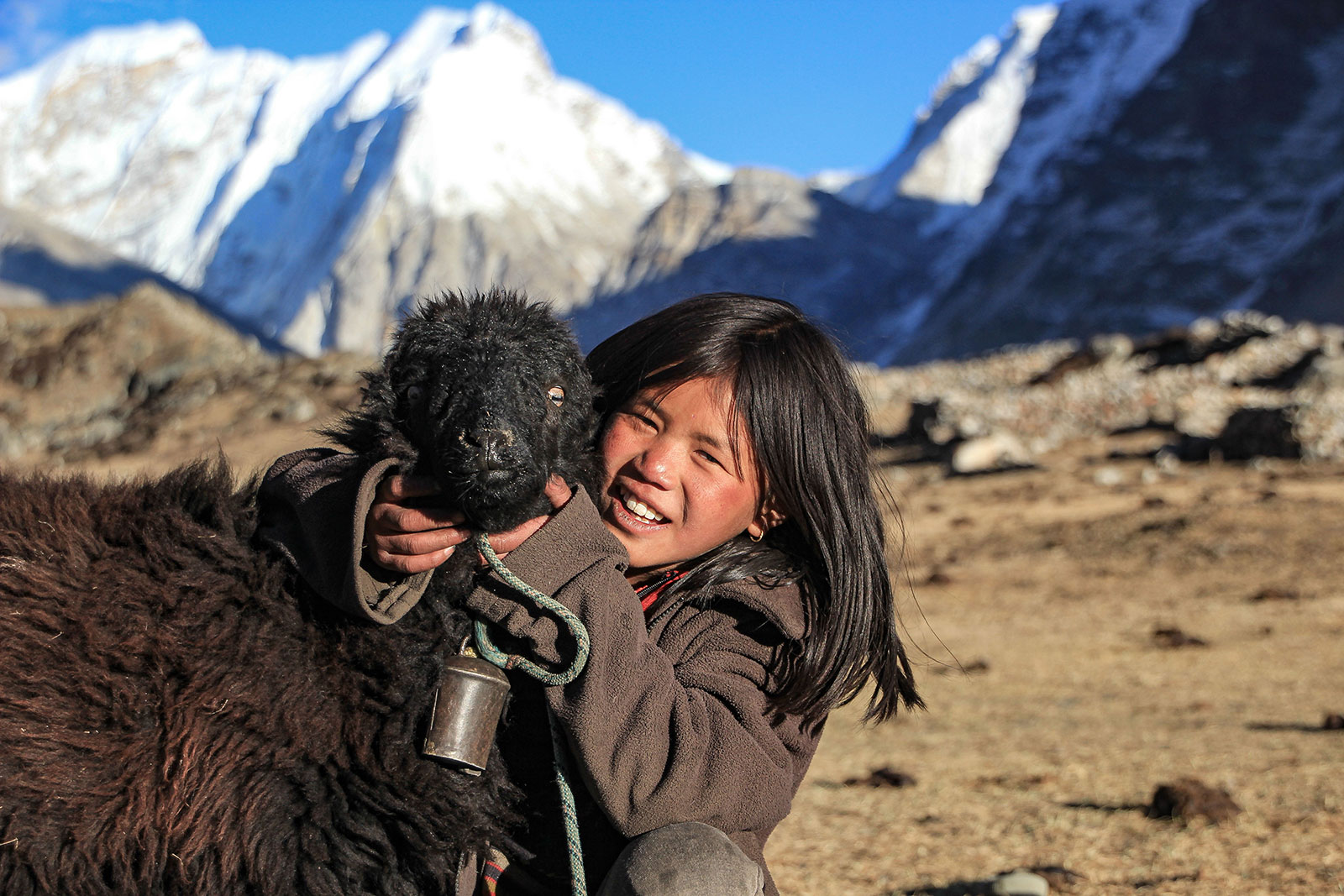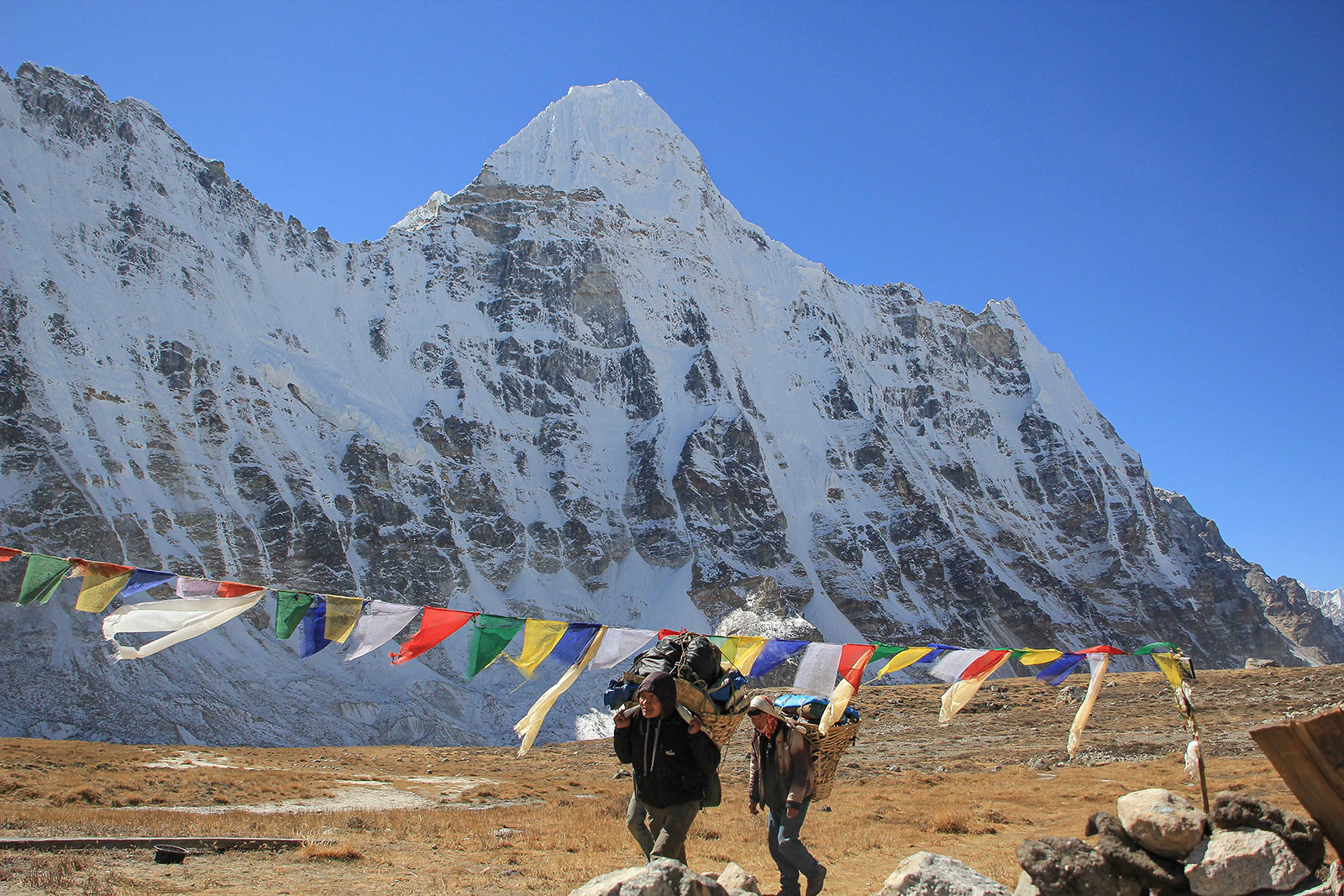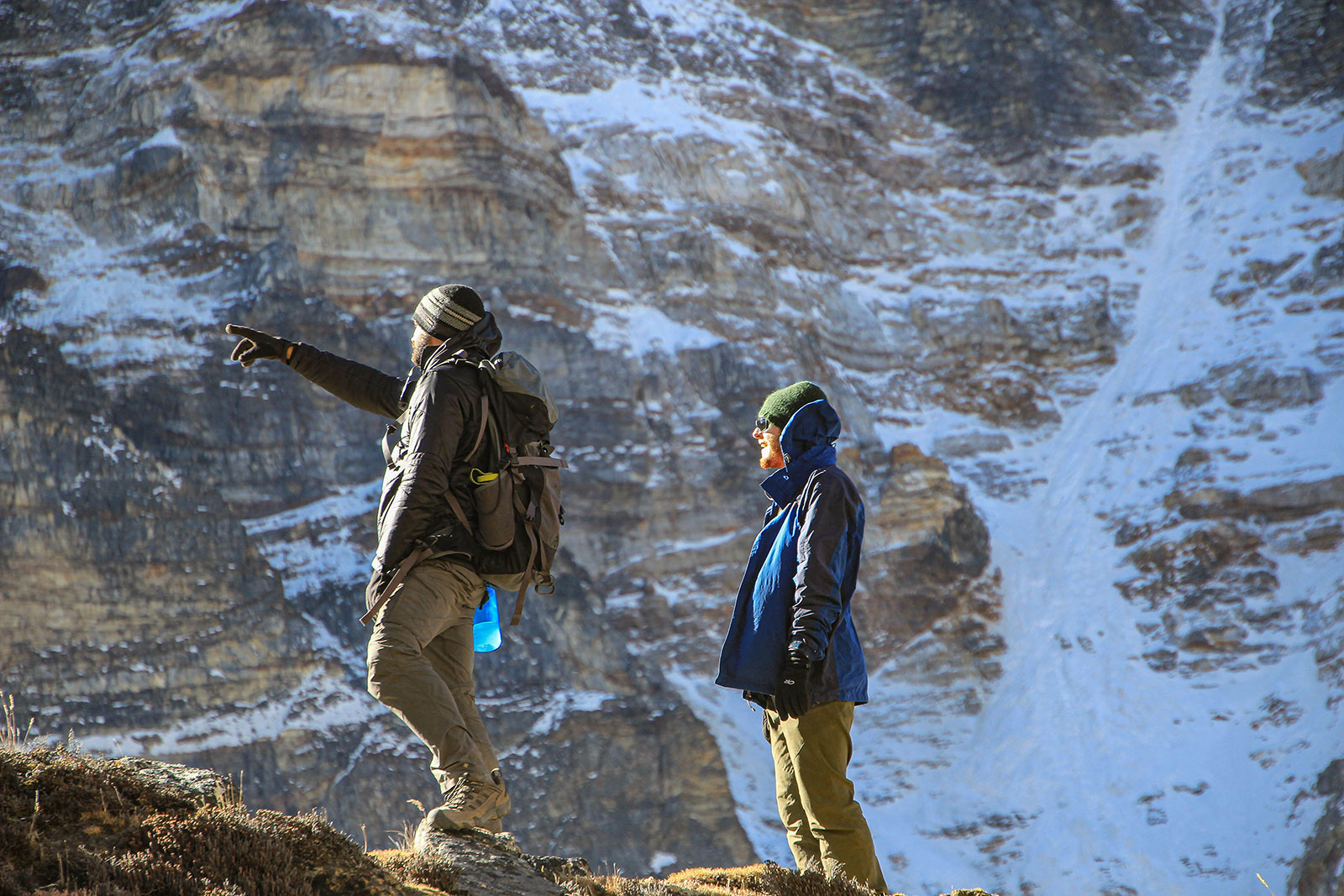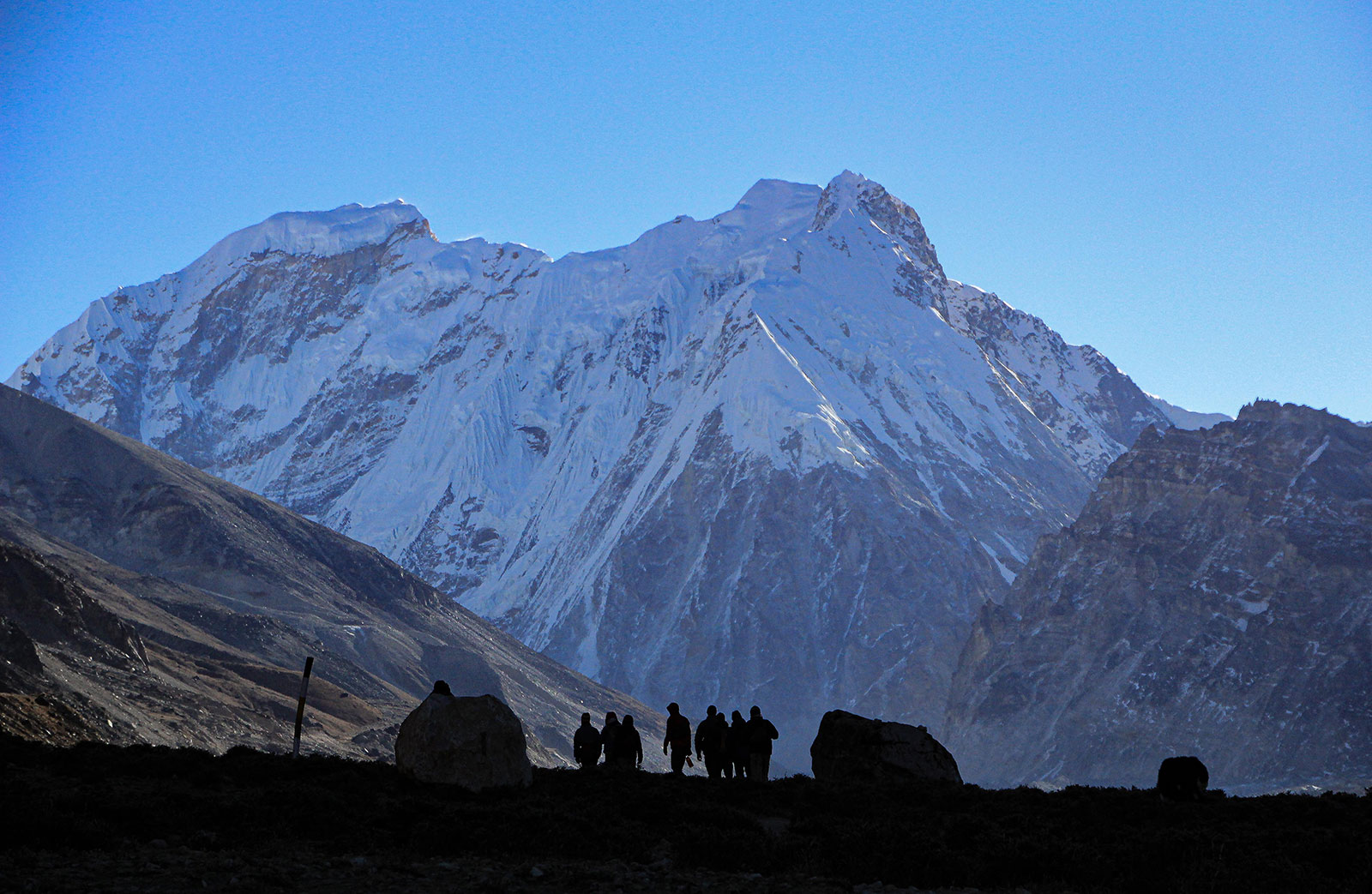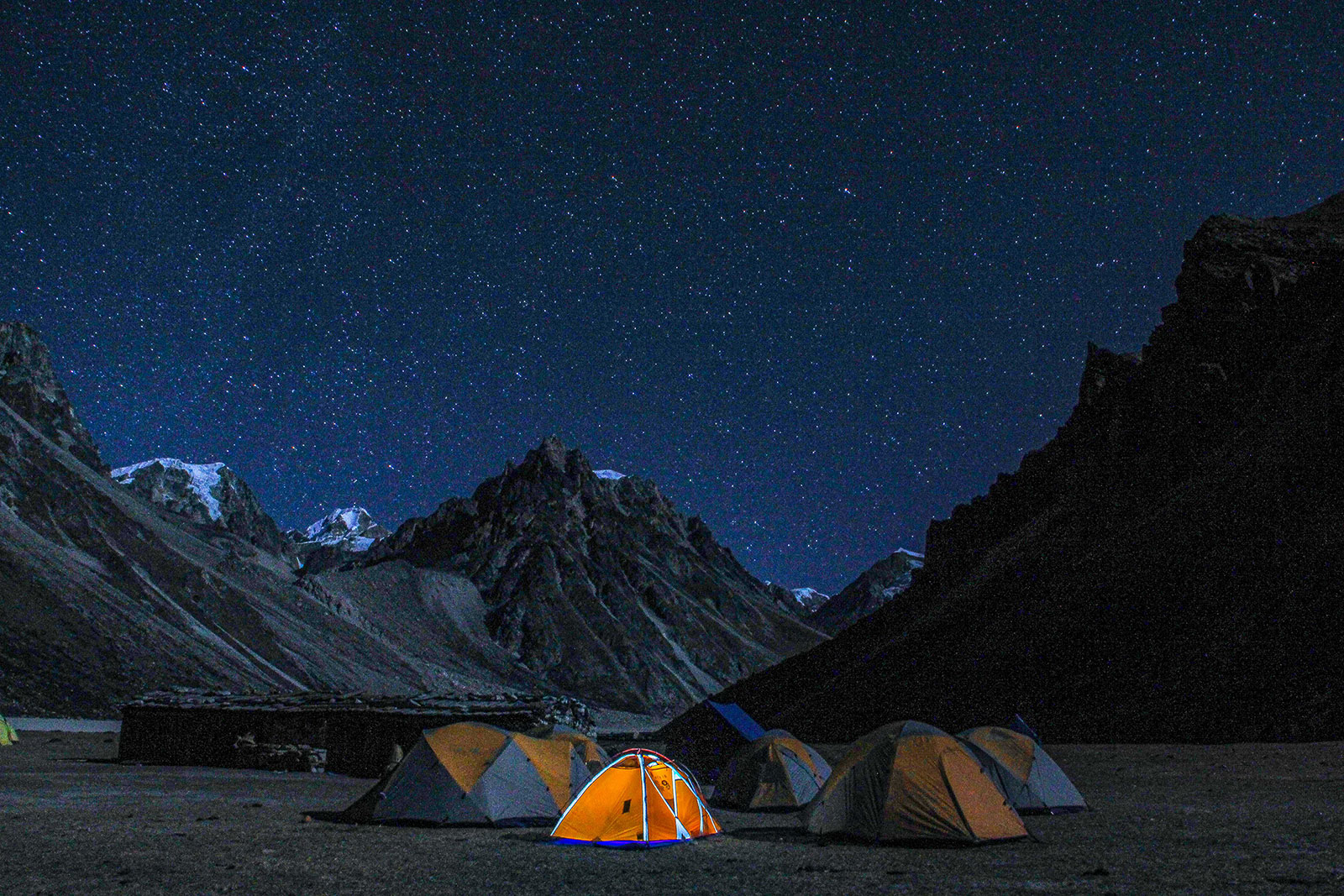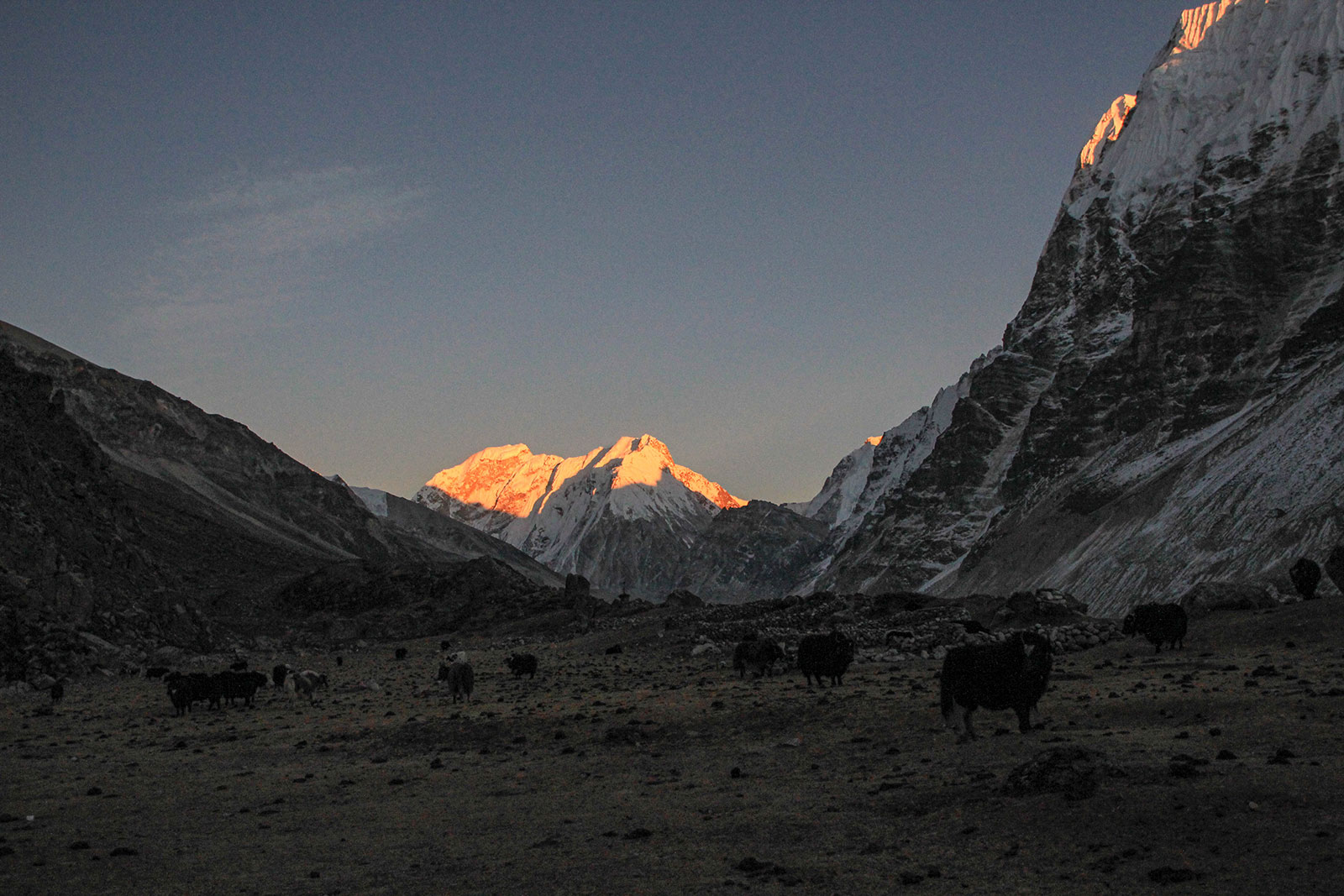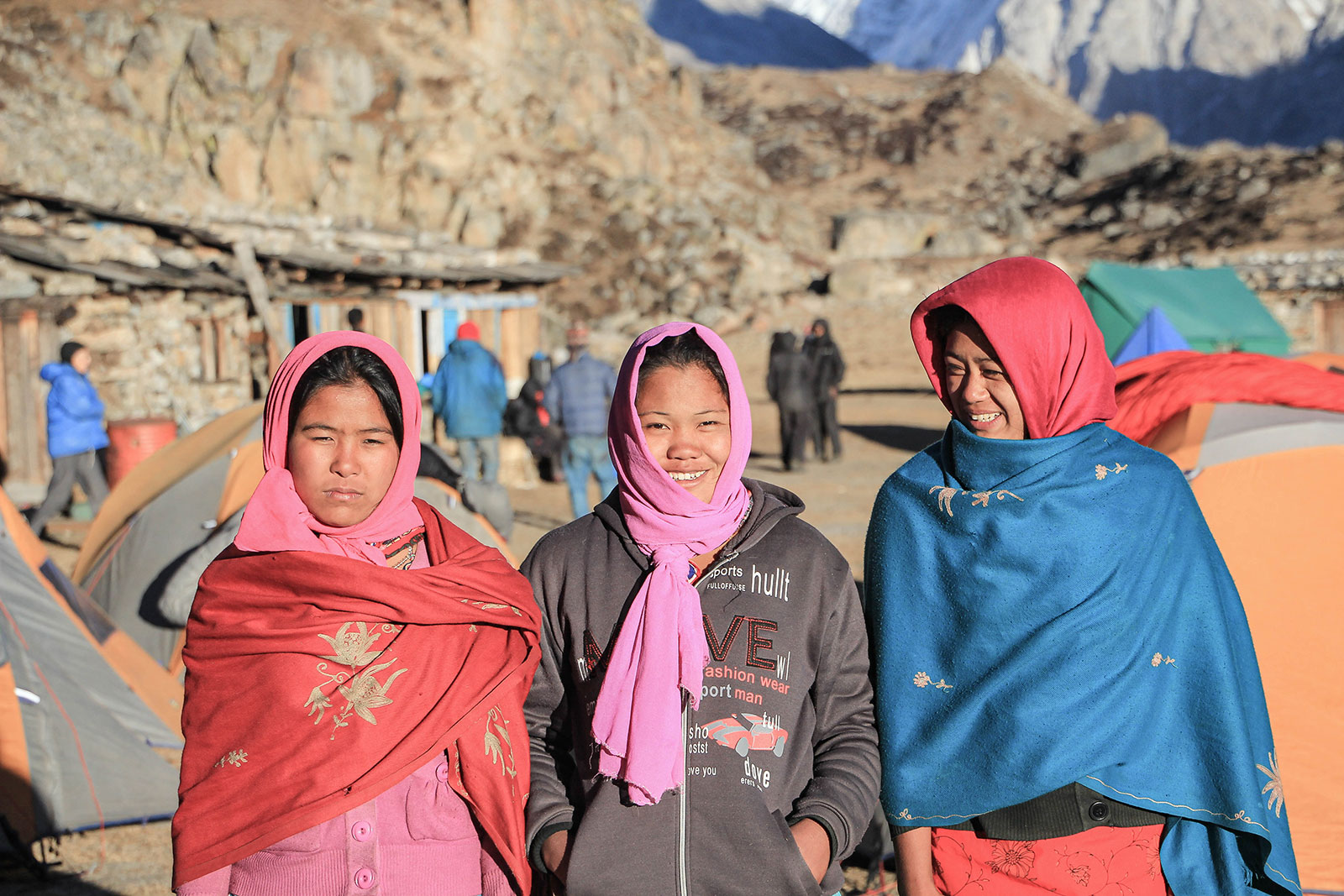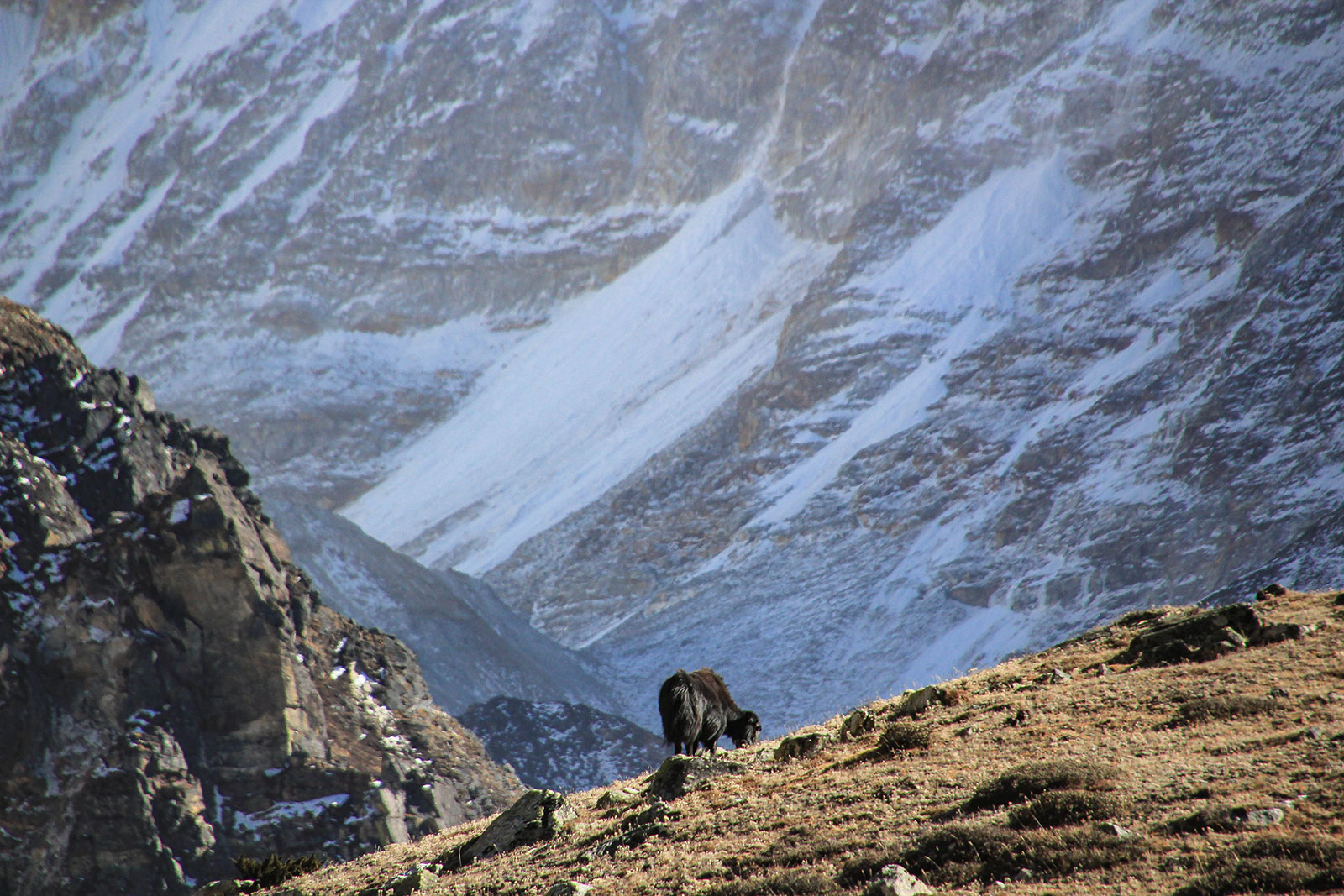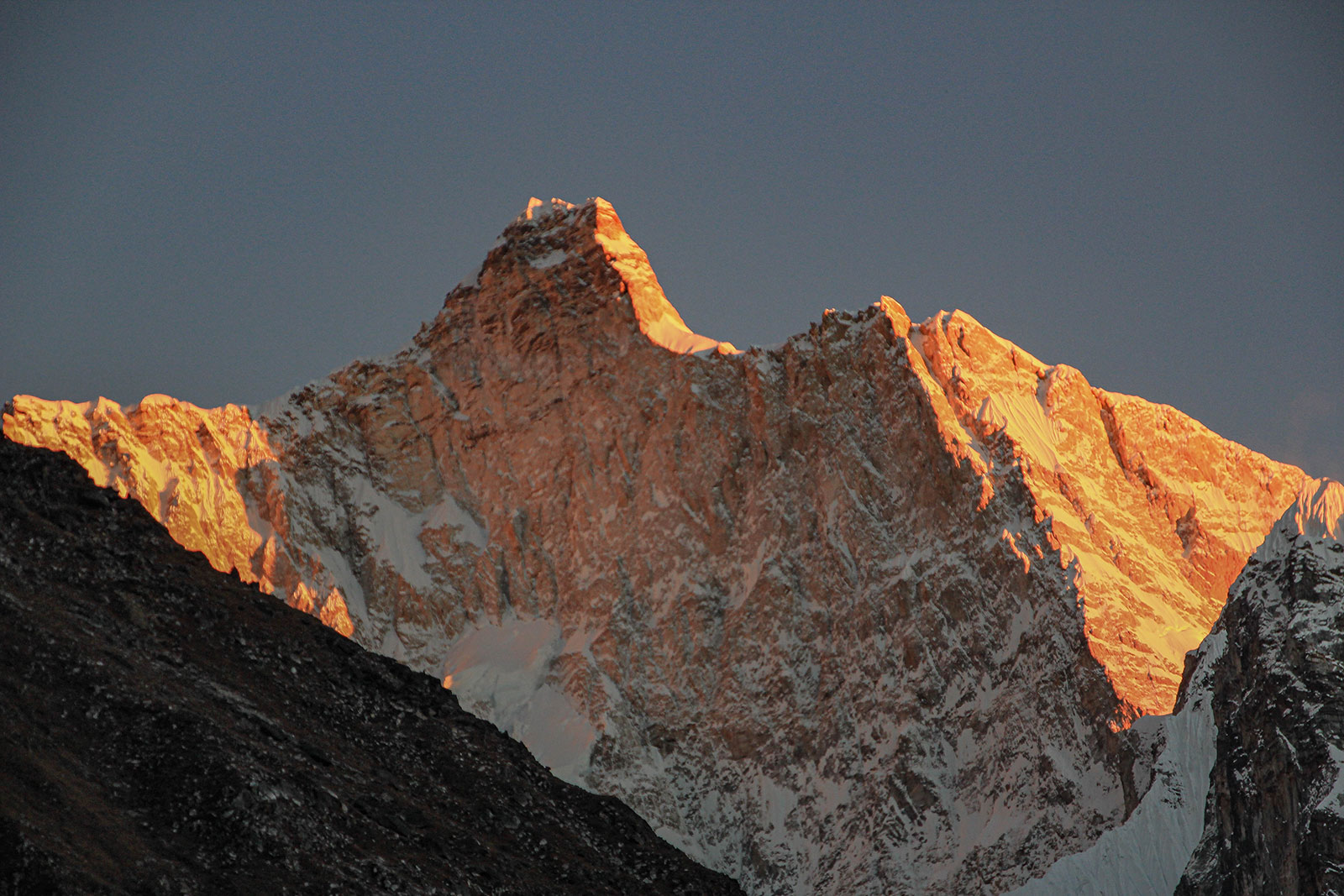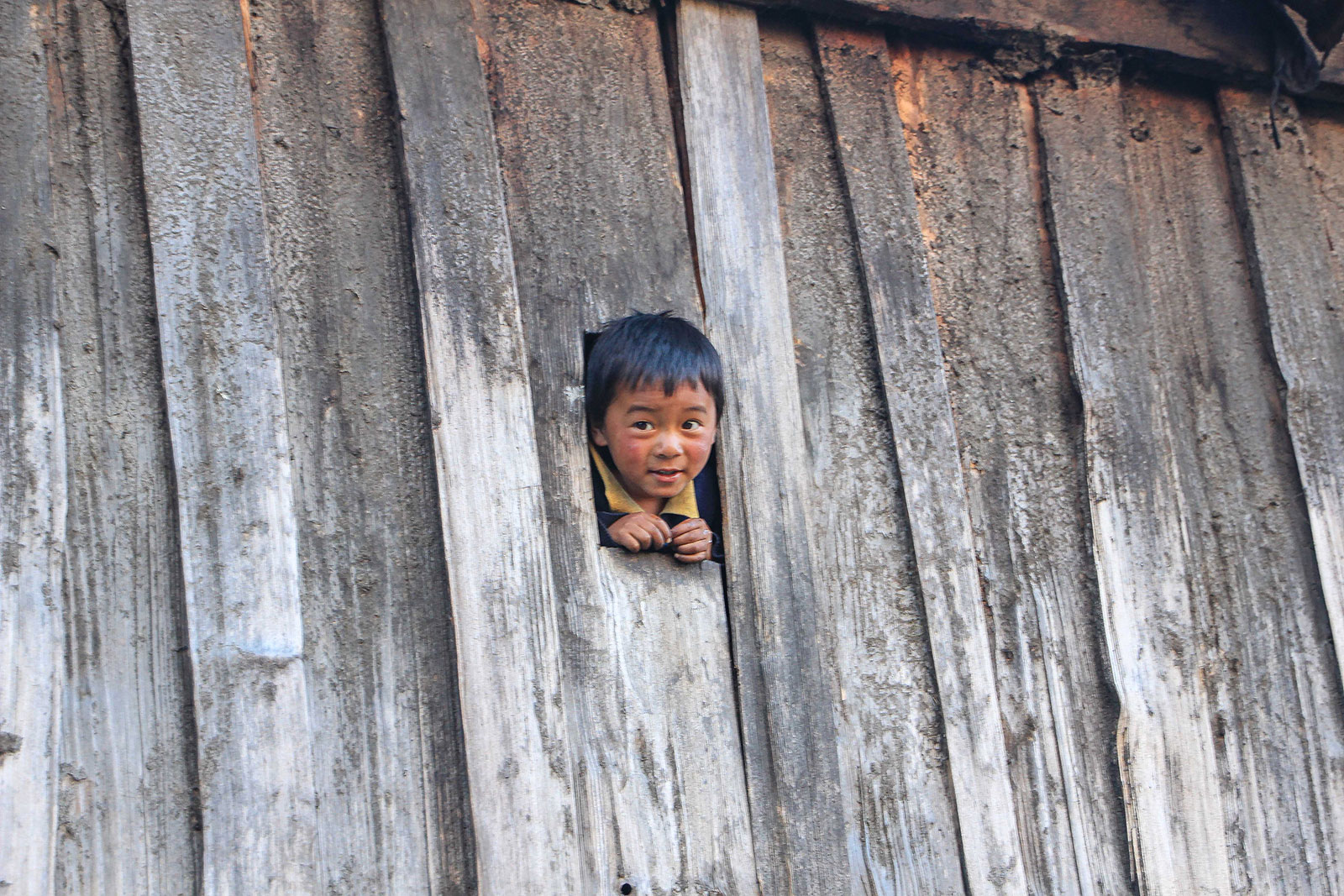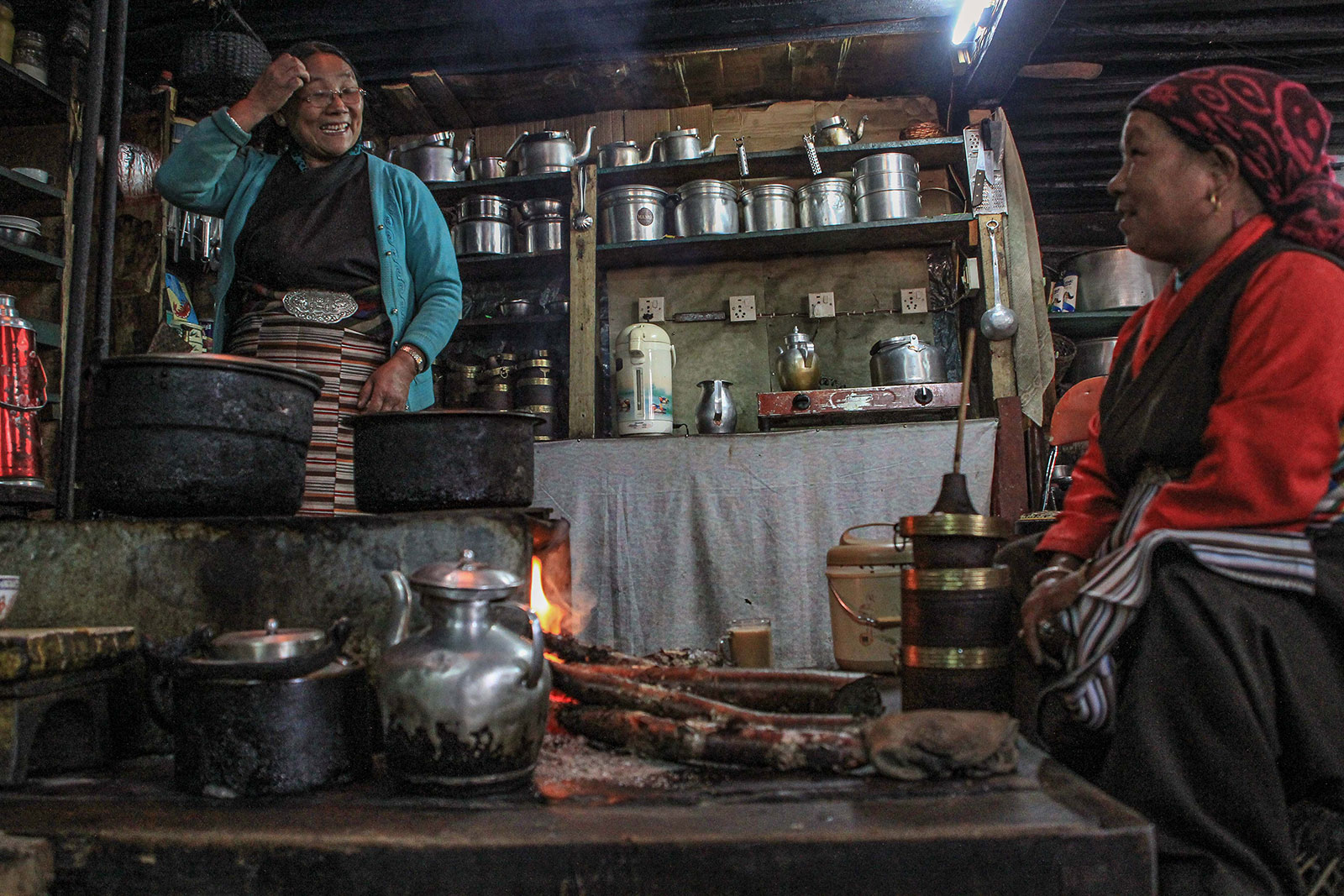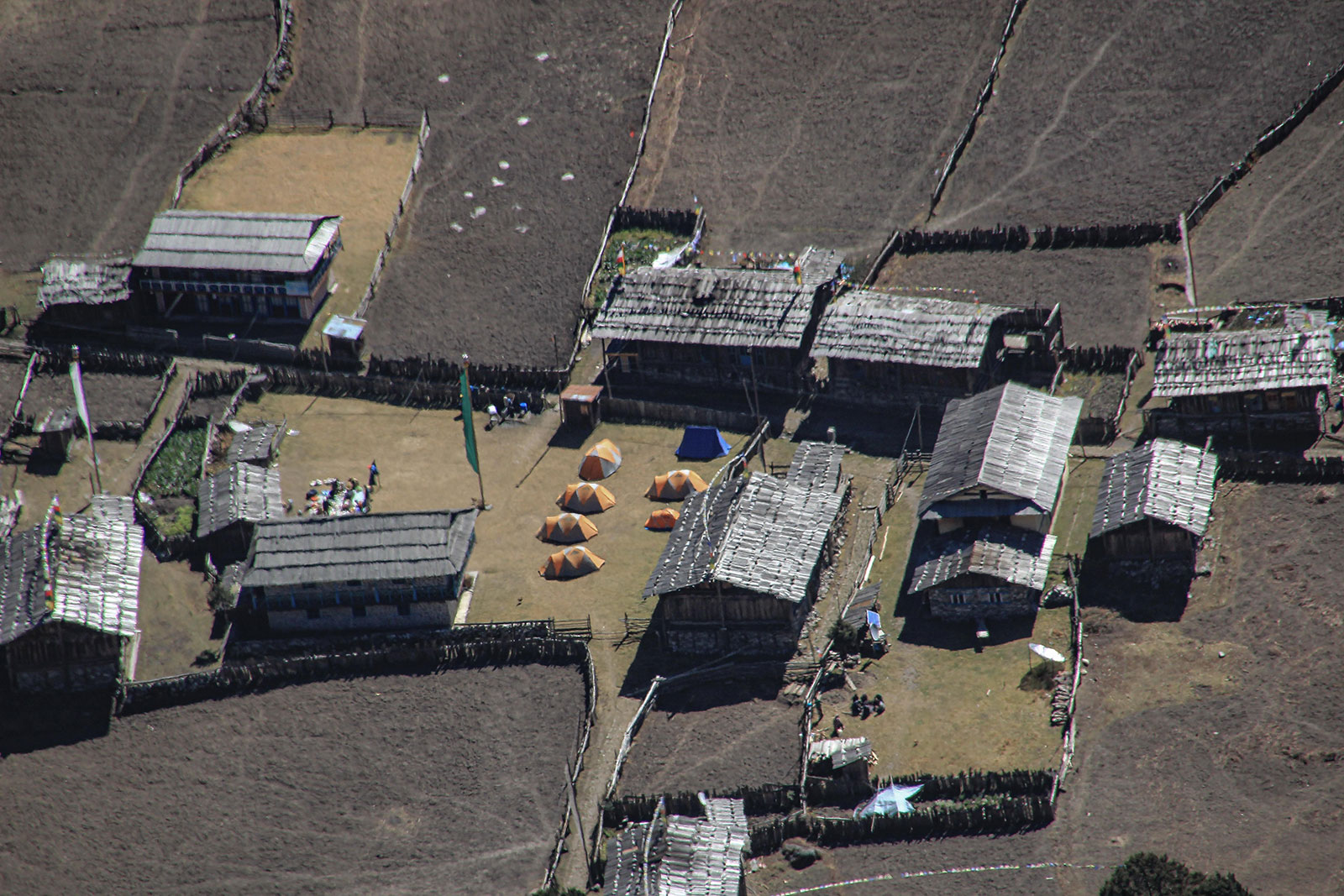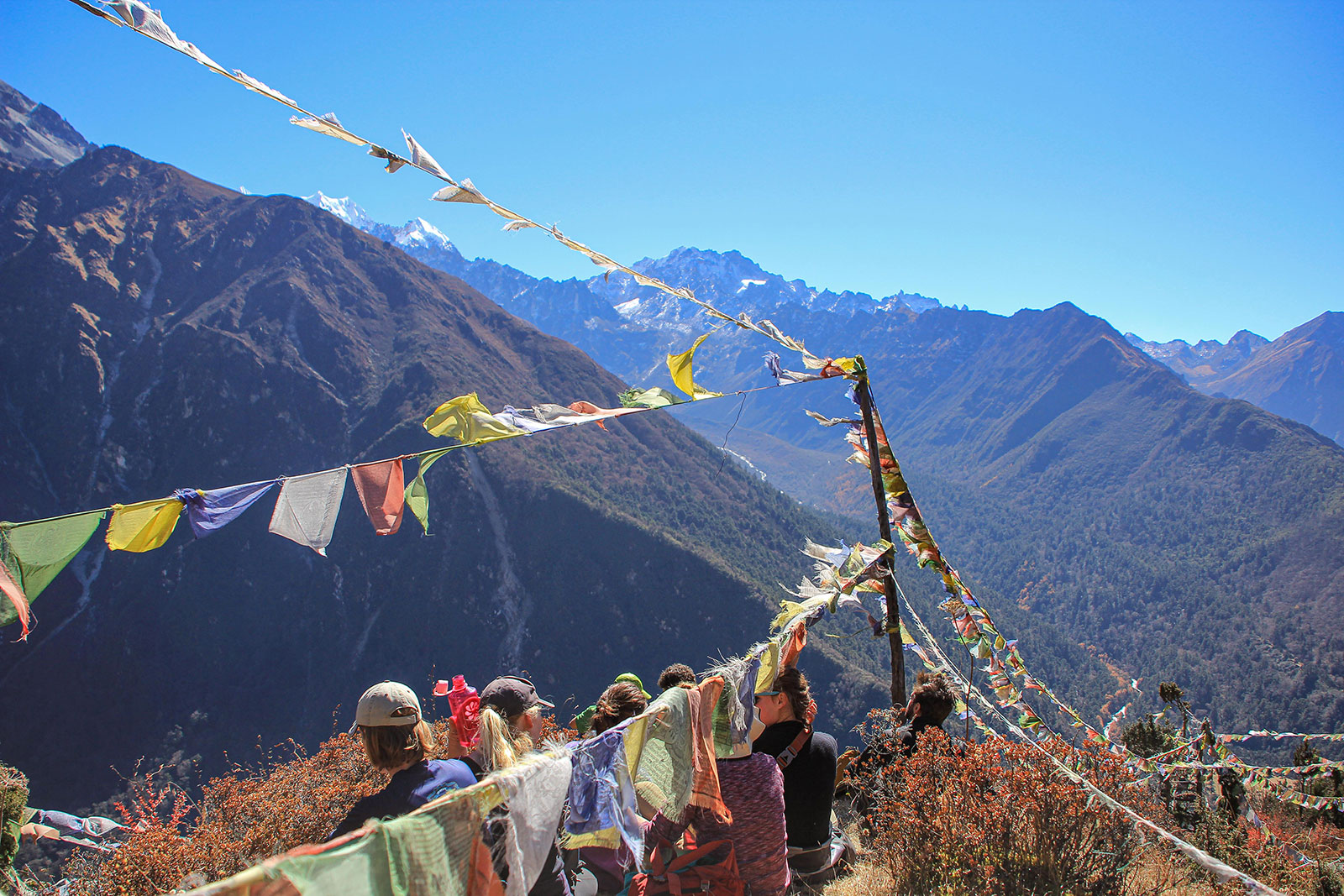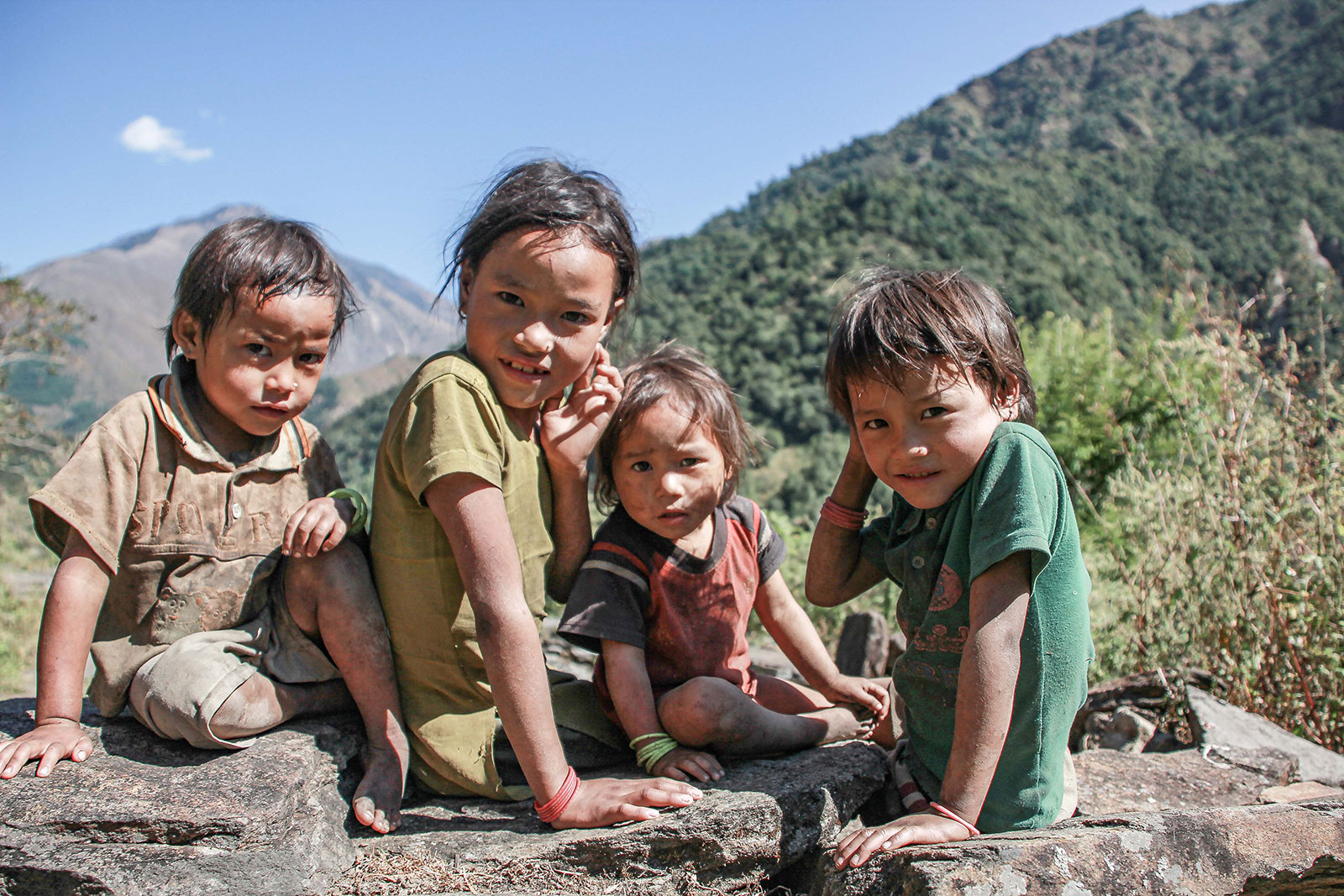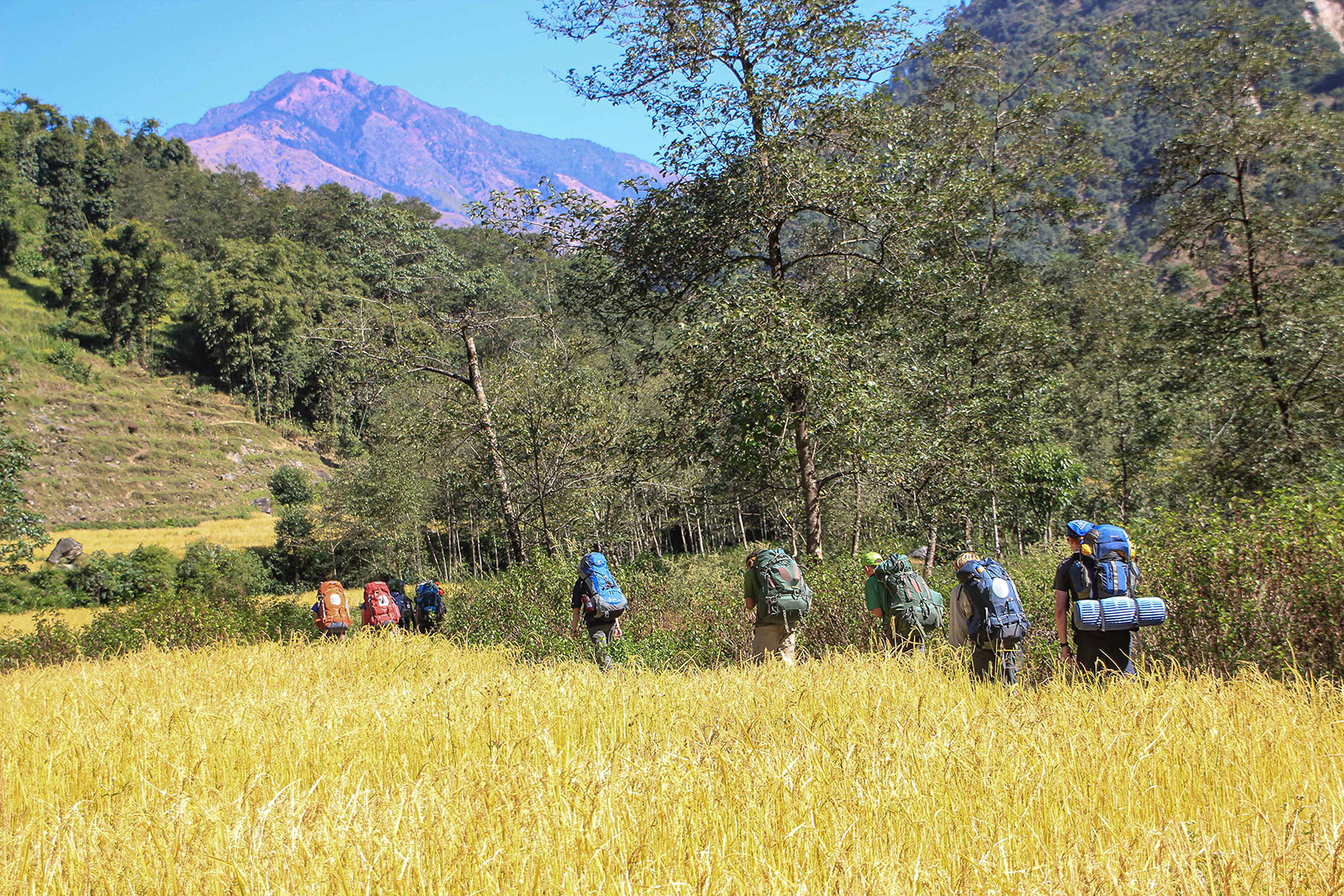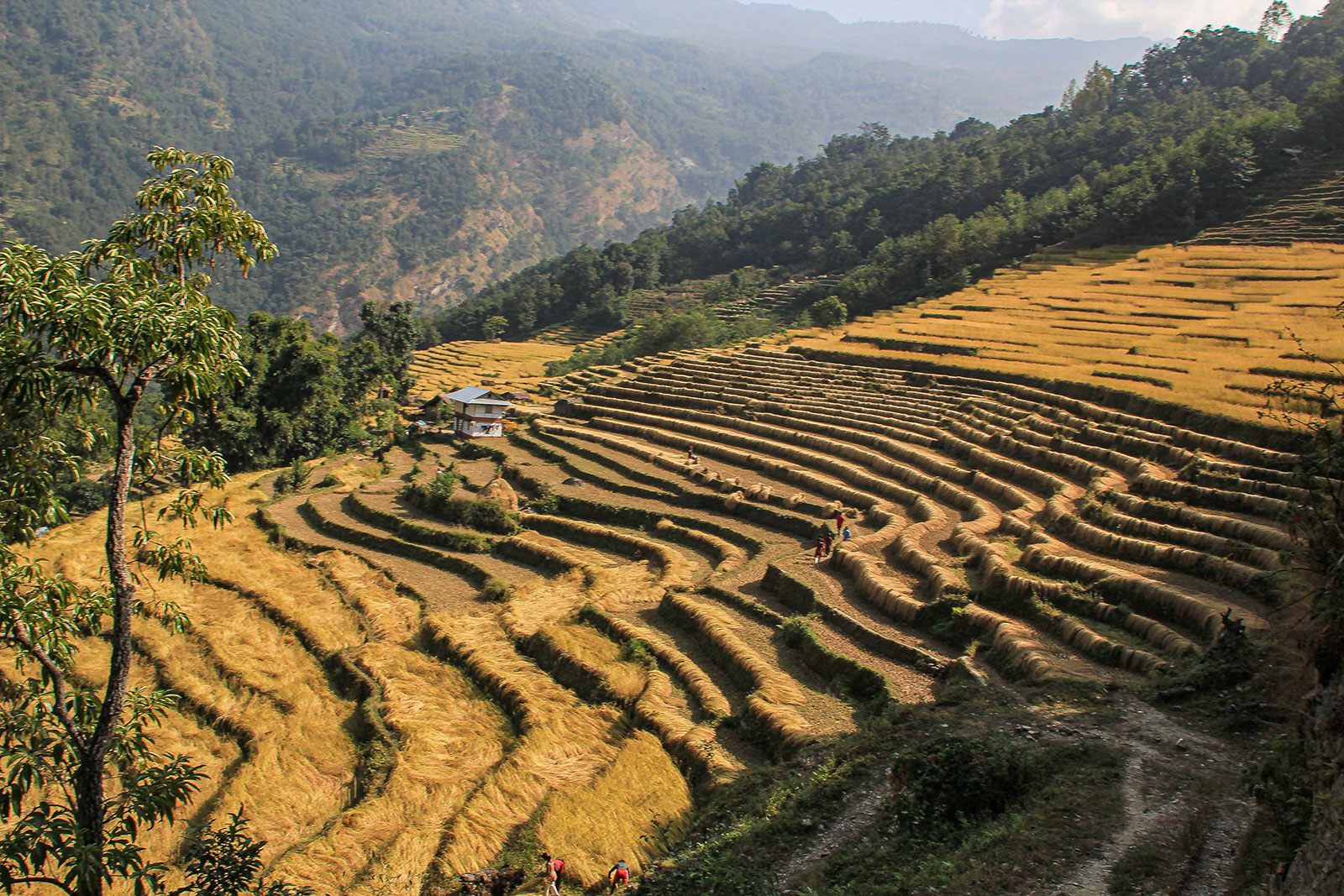Kanchenjunga Base Camp Trek
Kanchenjunga Base Camp Trek
DAYS
26
DIFFICULTY
Moderate/Strenuous
MAX ALTITUDE
5,143 M
ACCOMMODATION
Camping/Teahouses
DAYS
26
DIFFICULTY
Moderate/ Strenuous
MAX ALTITUDE
5143 M
ACCOMMODATION
Camping/ Tea House
Trip Overview
Kanchenjunga (8,586m), ‘The Five Great Treasure Houses of Snow’, is the world’s third-highest mountain and is situated in the Kanchenjunga Conservation Area, an area that comprises pristine forests, alpine meadows and high altitude wetlands alongside this magnificent and spectacular Himalayan massif.
The mountain forms Nepal’s eastern border with Sikkim and this region is one of the least populated in Nepal. You will trek up through lush, green, semi-tropical Rai and Limbu villages in the mid-hills, and remote Tibetan villages higher up in the semi-arid plateaus at the foot of the mountain.
This remote, stunningly beautiful and ecologically diverse conservation area is jointly managed by local communities and the WWF and is home to the endangered and secretive snow leopard and red panda, as well as the vulnerable Himalayan black bear, clouded leopard, and Assamese macaque.
This circular trek takes you up through lush valleys full of seasonal flowers that receive the heaviest monsoon rains throughout the Himalayan range, north into spectacular high alpine landscapes full of woodlands and mountain streams. You will then trek up over high passes to both Kanchenjunga Base Camp and Ramche Yalung Base Camp, before heading back down again to lower elevations and returning to the trek’s start point at Taplejung.
Day 1: Arrival in Nepal and passport to Himalayan Quests
Day 2: Trek briefing and preparation
Day 3: Flight Kathmandu to Badrapur – Drive to Taplejung (1,820m)
Day 4: Trek Taplejung – Mitlung (921m) 5-6 hours
Day 5: Trek Mitlung – Chiruwa (1,270m) 5-6 hours
Day 6: Trek Chiruwa – Sukethum (1,579m) 5 hours
Day 7: Trek Sukethum – Amjlosa (2,308m) 6 hours
Day 8: Trek Amjilosa – Gyabla (2,730m) 5-6 hours
Day 9: Trek Gyabla – Ghunsa (3,595m) 5-6 hours
Day 10: Ghunsa acclimatisation day
Day 11: Trek Ghunsa – Khangpachen (4,050m) 7 hours
Day 12: Trek Khangpachen – Lhonak (4,780m) 7 hours
Day 13: Trek Lhonak – Kanchenjunga Base Camp (5,143m) 3 hours
Day 14: Trek Kanchenjunga Base Camp – Ghunsa (3,595m) 8 hours
Day 15: Trek Ghunsa – Tseram (3,870m) 8 hours
Day 16: Trek Tseram – Ramche (4,580m) 7 – 8 hours
Day 17: Trek Ramche – Yalung Base Camp (4,500m) 7-8 hours
Day 18: Trek Yalung Base Camp – Lapsang (4,432m) 6 hours
Day 19: Trek Lapsang – Tortong (2,995m)
Day 20: Trek Tortong – Yamphudim (2,080m)
Day 21: Yamphudim – Rest day
Day 22: Trek Yamphudim – Phumpe (1,858m)
Day 23: Trek Ponphe – Pha Khola (1,550m)
Day 24: Trek Pha Khola – Suketar (2,420m)
Day 25: Long Drive from Taplejung to Bhadrapur
Day 26: Fly to Kathmandu
Notes:
The trek itinerary is a guide only and may be subject to change at short notice
In order to obtain your Kanchenjunga restricted access permit, we need your original passport at least 2 working days before departure
Day 1: Arrival in Nepal and passport to Himalayan Quests
Day 2: Trek briefing and preparation
Day 3: Flight Kathmandu to Badrapur and then a long drive to Taplejung (1,820m)
Day 4: Taplejung – Mitlung (921m). Today we walk down to the Tamur River and then follow it upstream, stopping for lunch at Handewa. We will be following the Great Himalaya Trail Cultural Route, a spectacular and interesting route through some of Nepal’s most remote villages. Approx. 5-6 hours.
Day 5: Mitlung – Chiruwa (1,270m). Today is quite challenging as we follow rough paths high above the river. The trail passes through the Limbu and Tamang villages of Sinwa, Tawa and Porke and as the valley narrows, passes over old landslide debris and boulder-strewn river deposits. We will finally descend to the Thiwa Khola, crossing it on a wooden bridge, before the final leg of up and down arriving at the small market town of Chirwa our stop for the night, approx. 5-6 hours
Day 6: Chiruwa – Sukethum (1,579m). Today we pass through Limbu, Rai, Tamang, and Sherpa villages. The trail follows the Tamur River and climbs a spur before descending to the Simbua Khola, which originates from the Yalung Glacier on the south of Kanchenjunga. After another ridge, we join the steep and narrow Ghunsa Khola Valley and then where the confluence of the Tamur River and Ghunsa Khola meet it is only a short walk to our campsite on the banks of the river at Sukethum, approx. 5 hours.
Day 7: Sukethum – Amjlosa (2,308m). From Sukethum we trek northeast along the Ghunsa Khola gaining altitude as we head towards Kanchenjunga South Base Camp. Today’s walking is on exposed terrain with steep uphill after our lunch stop at Jaubari, bringing us to the Tibetan village of Amjilossa where we will camp for the night, approx. 6 hours.
Day 8: Amjilosa – Gyabla (2,730m). Today we will walk through rhododendron and bamboo forests. After lunch, we will start our ascent to our final destination of the day, Gyabla. Nearing our destination, we need to keep an eye out for a big waterfall on the opposite side of the river as this signals our imminent arrival at our campsite, one of the most beautiful campsites of the trek, with amazing views, approx. 5-6 hours.
Day 9: Gyabla – Ghunsa (3,595m). Today we head for not only the largest but also the last village in the valley, Ghunsa. Ghunsa is a picturesque Tibetan village with wooden houses, a micro hydropower plant, school, and a health post. There are also several lodges and shops in the village and a small Kanchenjunga Conservation Area office, plus a couple of gompas. Ghunsa is the junction for all the trekkers coming and going to KBC and the Sale La Pass. From Gyabla, the trail crosses a broad meadow past a village and climbs a gentle hill before descending to cross the river into the village of Ghunsa, approx. 5-6 hours.
Day 10: Ghunsa acclimatisation day. Today we do a morning acclimatisation hike to the other side of the river with a gain of about 400 m, taking about 3.5 hours for the round trip. The rest of the day can be spent relaxing and exploring the lively Tibetan village of Ghunsa.
Day 11: Ghunsa – Khangpachen (4,050m). From Ghunsa the trail makes a gradual ascent through beautiful pine and rhododendron forests along the south bank of the Ghunsa Khola, passing several mani walls and chortens along the way. We will have to cross several scree slopes and some glacial moraine before we drop down to Khambachen, our home for the night. Khambachen is a Tibetan settlement with about a dozen houses nestled in a grassy plain, surrounded by mountains and a very impressive view of the huge north face of Jannu, approx. 7 hours.
Day 12: Khangpachen – Lhonak (4,780m). Reaching the source of the Ghunsa Khola, we’ll stay on the left (north) side of the Kanchenjunga Glacier, hiking along a high plateau past the intersecting Lhonak Glacier to our left to reach the high, flat campsite at Lhonak. Although a cold campsite due to its high elevation, the views are fantastic as we will be surrounded by some of the highest snow-peaks on the planet – Wedge Peak (6,750m), Mera Peak (6344m), Nepal Peak (6910m), Twins (7,351m) among others, approx. 7 hours.
Day 13: Lhonak – Kanchenjunga Base Camp (5,143m). After leaving Lhonak we head directly east following the same glacier on the northern ridges to a fantastic campsite at Kanchenjunga North Base Camp, also called Pang Pema. Camping here is one of the highlights of the trek and makes us realize just how small and insignificant we are in this world of snow and rock, approx. 3 hours.
Day 14: Kanchenjunga Base Camp – Ghunsa (3,595m). Today is a long day as we retrace our footsteps back to Ghunsa where we stay for the night, approx. 8 hours.
Day 15: Ghunsa – Tseram (3,870m). Today is a bit of an epic, taking us over passes on our way to Tseram, the highest being Sele La (4,480m) and Sinion La (4,660m). After completing the final pass of the day, we descend 1,000m to Tseram, where we will camp for the night, approx. 8 hours.
Day 16: Tseram – Ramche (4,580m). Today we walk up to Ramche, where we pass the snout of the Yalung glacier into an ablation valley. All the peaks to the east straddle the India-Nepal border, Koktang (6,147m), Rathong (6,679m) and some of the Kabrus which are all over 7,000m. There is a lake and a meadow along with two stone houses at Ramche and blue sheep can often be seen on the grassy slopes above. Approx. 7 – 8 hours.
Day 17: Ramche – Yalung Base Camp (4,500m). Trekking this day is pretty adventurous, as you have to walk along the glaciers. Today you cross the Oktang glacier, giving panoramic views of Kanchenjunga and Mount Jannu amongst others. We stay overnight at Yalung Base Camp. Approx. 7 – 8 hours
Day 18: Yalung Base Camp – Lapsang (4,432m). This day you retrace your steps back to Lapsang, approx. 6 hours
Day 19: Lapsang – Tortong (2,995m). We are starting to descend from today. We steadily descend through a forest of rhododendrons to Torontam. Approx 5 hours.
Day 20: Tortong – Yamphudim (2,080m). The trail drops steeply to the Imja Khola then crosses the Dubi Pass and descends into Yamphudin. The village has a mixed community of Sherpas, Rais, Limbus, and Gurungs and is also home to a Kanchenjunga Conservation Area office. Approx 5 – 6 hours.
Day 21: Yamphudim – Rest day
Day 22: Yamphudim – Phumpe (1,858m). We descend from Yamphudin to the Kabele Khola and climb to Phumpe for our camp. Approx. 5-6 hours
Day 23: Phumpe – Pha Khola (1,500m). From Phumpe we climb to a ridge and then descend through a series of side valleys past Phun village to Kesawa (2,120m). The trail ascends to the Gurung settlement at Bhanjyang. From here the trail traverses a ridge and descends to the Limbu village of Khanjari. We camp below on the banks of Pha Khola. Approx. 6-7 hours.
Day 24: Pha Khola – Suketar (2,420m). We descend today to the airport at Suketar for our overnight camp. This will be our last night to celebrate with our crew and porters. Approx 5 hours.
Day 25: Drive to Bhadrapur.
Day 26: Fly to Kathmandu.
Notes:
The trek itinerary is a guide only and may be subject to change at short notice
In order to obtain your Kanchenjunga restricted access permit, we need your original passport at least 2 working days before departure
Himalayan Quests uses a layering system where different pieces of clothing are worn together or separately to achieve optimum body temperature control. The upper body garments listed here are either synthetic or merino wool garments that retain their insulating properties when wet, or nylon or Gore-Tex layers which help prevent heat loss by cutting wind, rain, and snow.
This is a guideline only
| UPPER BODY LAYERS | ||
| Equipment | Quantity | Comments |
| T-Shirts – walking | 2 | We recommend merino wool, Capilene or other synthetic fabric as they wick away the moisture and dry quickly. No cotton. |
| T-shirt – sleeping | 1 | This can be cotton |
| Base layers (ie thermal top) | 1 | Lightweight or mid-weight long-sleeved t-shirt of merino wool, polyester, Capilene, or Polartec power dry |
| Top insulating Layers | 1 | Mid-weight fleece that can be worn over other layers |
| Fleece Vest | 1 | |
| Rain jacket | 1 | |
| Down Jacket | 1 | |
| LOWER BODY LAYERS | ||
| Equipment | Quantity | Comments |
| Underwear | Sufficient for the trek (remember you can wash them) | |
| Thermal long johns/long underwear | 1 | |
| Trekking Trousers | 2 | Lightweight quick-dry trousers (no cotton). Zip offs are good |
| Evening/sleeping trousers | 1 optional | 1 pair of lightweight tracksuit bottoms (sweat pants) or yoga style trousers for evening wear and sleeping in. No jeans. |
| Hiking Shorts | 1 | If no zip-off trousers. Below the knee for ladies |
| Rain Pants | 1 | |
| PACKS & BAGS | ||
| Equipment | Quantity | Comments |
| Day pack | 1 | Approx. 35ltrs. HQ will provide you with a duffle bag for your trekking gear |
| Sleeping bag with compression sack | 1 | Minimum 3 season |
| Sleeping bag liner | 1 | Optional |
| FOOTWEAR | ||
| Equipment | Quantity | Comments |
| Hiking boots | 1 | Must be well worn and comfortable with ankle support |
| Socks | 3 | |
| Flip flops/Camp shoes | 1 | Lightweight for evening use |
| MISCELLANEOUS ITEMS | ||
| Equipment | Quantity | Comments |
| Water bottles | 2 | One liter each, Nalgene or Sig style or a bladder if preferred |
| Water purification drops | 1 | Cheap and easy to buy in Kathmandu (Piyus) |
| Lip Balm | 1 | With SPF factor |
| Sunscreen | 1 | We recommend SPF 30 or greater |
| Mosquito repellent | 1 | |
| Personal first aid kit | 1 | To include any prescribed medications |
| Sunglasses | 1 | |
| Bandana/Buff | 1 | Useful for a variety of purposes. |
| Flashlight /head torch | 1 | Head torch is best as it leaves your hands free + extra batteries |
| Travel towel | 1 | Lightweight and compact |
| Wash kit | Travel size items for the trek & eco friendly if possible | |
| Instant Hand Sanitizer | 1 | Alcohol-based for keeping hands clean |
| Sun hat | 1 | |
| Warm hat | 1 | |
| Gloves | 1 | |
| Trekking poles | Optional | |
| Trekking snacks | Good selection available in KTM | |
| Camera | With charger &/or extra batteries | |
| Toilet paper & rubbish bag | ||
| Book/journal | ||
| Pack of cards/travel game | 1 | For evening entertainment |
| Passport photos | Always useful and a must-have if you want a local sim card | |
| Photocopies of all your important documents | ||
| A great sense of humor & a positive attitude | Essential – don’t come without it!! J | |
Your trek cost includes:
- Pre-trip advice and detailed information
- Expert trip leadership and motivated staff for the duration of the trek
- Airport transfers in Nepal (where applicable)
- 2 nights accommodation pre-trek & 1-night post-trek in Kathmandu
- 1-night accommodation pre or post-trek in Pokhara (where applicable)
- Transportation to and from trek start and finish for you and your trekking team (different budget options available)
- Basic teahouse/lodge/camping accommodation during the trek on a twin sharing basis
- During the trek all meals on a full board basis (breakfast, lunch, and dinner) to include tea/coffee during the meals, but excluding any drinks outside of the meal times
- All permits, conservation area, and restricted area fees
- Porters
- Insurance and equipment for Nepali staff
- Rescue assistance
- Group medical kit
Your trek cost does NOT include:
- International flights to and from Kathmandu, Nepal
- Visa for Nepal
- Travel insurance (insurance to include evacuation is mandatory. Please make sure you are covered to the correct altitude)
- Personal expenses such as fizzy drinks, chocolate, gifts, snacks, hot showers during the trek, etc.
- Meals unless specified
- Sightseeing
- Gratuities
- Excess baggage on internal flights
- Charges incurred as a result of delays beyond the control of Himalayan Quests
Day 1: Arrival in Nepal and passport to Himalayan Quests
Day 2: Trek briefing and preparation
Day 3: Flight Kathmandu to Badrapur – Drive to Taplejung (1,820m)
Day 4: Trek Taplejung – Mitlung (921m) 5-6 hours
Day 5: Trek Mitlung – Chiruwa (1,270m) 5-6 hours
Day 6: Trek Chiruwa – Sukethum (1,579m) 5 hours
Day 7: Trek Sukethum – Amjlosa (2,308m) 6 hours
Day 8: Trek Amjilosa – Gyabla (2,730m) 5-6 hours
Day 9: Trek Gyabla – Ghunsa (3,595m) 5-6 hours
Day 10: Ghunsa acclimatisation day
Day 11: Trek Ghunsa – Khangpachen (4,050m) 7 hours
Day 12: Trek Khangpachen – Lhonak (4,780m) 7 hours
Day 13: Trek Lhonak – Kanchenjunga Base Camp (5,143m) 3 hours
Day 14: Trek Kanchenjunga Base Camp – Ghunsa (3,595m) 8 hours
Day 15: Trek Ghunsa – Tseram (3,870m) 8 hours
Day 16: Trek Tseram – Ramche (4,580m) 7 – 8 hours
Day 17: Trek Ramche – Yalung Base Camp (4,500m) 7-8 hours
Day 18: Trek Yalung Base Camp – Lapsang (4,432m) 6 hours
Day 19: Trek Lapsang – Tortong (2,995m)
Day 20: Trek Tortong – Yamphudim (2,080m)
Day 21: Yamphudim – Rest day
Day 22: Trek Yamphudim – Phumpe (1,858m)
Day 23: Trek Ponphe – Pha Khola (1,550m)
Day 24: Trek Pha Khola – Suketar (2,420m)
Day 25: Long Drive from Taplejung to Bhadrapur
Day 26: Fly to Kathmandu
Notes:
The trek itinerary is a guide only and may be subject to change at short notice
In order to obtain your Kanchenjunga restricted access permit, we need your original passport at least 2 working days before departure
Day 1: Arrival in Nepal and passport to Himalayan Quests
Day 2: Trek briefing and preparation
Day 3: Flight Kathmandu to Badrapur and then a long drive to Taplejung (1,820m)
Day 4: Taplejung – Mitlung (921m). Today we walk down to the Tamur River and then follow it upstream, stopping for lunch at Handewa. We will be following the Great Himalaya Trail Cultural Route, a spectacular and interesting route through some of Nepal’s most remote villages. Approx. 5-6 hours.
Day 5: Mitlung – Chiruwa (1,270m). Today is quite challenging as we follow rough paths high above the river. The trail passes through the Limbu and Tamang villages of Sinwa, Tawa and Porke and as the valley narrows, passes over old landslide debris and boulder-strewn river deposits. We will finally descend to the Thiwa Khola, crossing it on a wooden bridge, before the final leg of up and down arriving at the small market town of Chirwa our stop for the night, approx. 5-6 hours
Day 6: Chiruwa – Sukethum (1,579m). Today we pass through Limbu, Rai, Tamang, and Sherpa villages. The trail follows the Tamur River and climbs a spur before descending to the Simbua Khola, which originates from the Yalung Glacier on the south of Kanchenjunga. After another ridge, we join the steep and narrow Ghunsa Khola Valley and then where the confluence of the Tamur River and Ghunsa Khola meet it is only a short walk to our campsite on the banks of the river at Sukethum, approx. 5 hours.
Day 7: Sukethum – Amjlosa (2,308m). From Sukethum we trek northeast along the Ghunsa Khola gaining altitude as we head towards Kanchenjunga South Base Camp. Today’s walking is on exposed terrain with steep uphill after our lunch stop at Jaubari, bringing us to the Tibetan village of Amjilossa where we will camp for the night, approx. 6 hours.
Day 8: Amjilosa – Gyabla (2,730m). Today we will walk through rhododendron and bamboo forests. After lunch, we will start our ascent to our final destination of the day, Gyabla. Nearing our destination, we need to keep an eye out for a big waterfall on the opposite side of the river as this signals our imminent arrival at our campsite, one of the most beautiful campsites of the trek, with amazing views, approx. 5-6 hours.
Day 9: Gyabla – Ghunsa (3,595m). Today we head for not only the largest but also the last village in the valley, Ghunsa. Ghunsa is a picturesque Tibetan village with wooden houses, a micro hydropower plant, school, and a health post. There are also several lodges and shops in the village and a small Kanchenjunga Conservation Area office, plus a couple of gompas. Ghunsa is the junction for all the trekkers coming and going to KBC and the Sale La Pass. From Gyabla, the trail crosses a broad meadow past a village and climbs a gentle hill before descending to cross the river into the village of Ghunsa, approx. 5-6 hours.
Day 10: Ghunsa acclimatisation day. Today we do a morning acclimatisation hike to the other side of the river with a gain of about 400 m, taking about 3.5 hours for the round trip. The rest of the day can be spent relaxing and exploring the lively Tibetan village of Ghunsa.
Day 11: Ghunsa – Khangpachen (4,050m). From Ghunsa the trail makes a gradual ascent through beautiful pine and rhododendron forests along the south bank of the Ghunsa Khola, passing several mani walls and chortens along the way. We will have to cross several scree slopes and some glacial moraine before we drop down to Khambachen, our home for the night. Khambachen is a Tibetan settlement with about a dozen houses nestled in a grassy plain, surrounded by mountains and a very impressive view of the huge north face of Jannu, approx. 7 hours.
Day 12: Khangpachen – Lhonak (4,780m). Reaching the source of the Ghunsa Khola, we’ll stay on the left (north) side of the Kanchenjunga Glacier, hiking along a high plateau past the intersecting Lhonak Glacier to our left to reach the high, flat campsite at Lhonak. Although a cold campsite due to its high elevation, the views are fantastic as we will be surrounded by some of the highest snow-peaks on the planet – Wedge Peak (6,750m), Mera Peak (6344m), Nepal Peak (6910m), Twins (7,351m) among others, approx. 7 hours.
Day 13: Lhonak – Kanchenjunga Base Camp (5,143m). After leaving Lhonak we head directly east following the same glacier on the northern ridges to a fantastic campsite at Kanchenjunga North Base Camp, also called Pang Pema. Camping here is one of the highlights of the trek and makes us realize just how small and insignificant we are in this world of snow and rock, approx. 3 hours.
Day 14: Kanchenjunga Base Camp – Ghunsa (3,595m). Today is a long day as we retrace our footsteps back to Ghunsa where we stay for the night, approx. 8 hours.
Day 15: Ghunsa – Tseram (3,870m). Today is a bit of an epic, taking us over passes on our way to Tseram, the highest being Sele La (4,480m) and Sinion La (4,660m). After completing the final pass of the day, we descend 1,000m to Tseram, where we will camp for the night, approx. 8 hours.
Day 16: Tseram – Ramche (4,580m). Today we walk up to Ramche, where we pass the snout of the Yalung glacier into an ablation valley. All the peaks to the east straddle the India-Nepal border, Koktang (6,147m), Rathong (6,679m) and some of the Kabrus which are all over 7,000m. There is a lake and a meadow along with two stone houses at Ramche and blue sheep can often be seen on the grassy slopes above. Approx. 7 – 8 hours.
Day 17: Ramche – Yalung Base Camp (4,500m). Trekking this day is pretty adventurous, as you have to walk along the glaciers. Today you cross the Oktang glacier, giving panoramic views of Kanchenjunga and Mount Jannu amongst others. We stay overnight at Yalung Base Camp. Approx. 7 – 8 hours
Day 18: Yalung Base Camp – Lapsang (4,432m). This day you retrace your steps back to Lapsang, approx. 6 hours
Day 19: Lapsang – Tortong (2,995m). We are starting to descend from today. We steadily descend through a forest of rhododendrons to Torontam. Approx 5 hours.
Day 20: Tortong – Yamphudim (2,080m). The trail drops steeply to the Imja Khola then crosses the Dubi Pass and descends into Yamphudin. The village has a mixed community of Sherpas, Rais, Limbus, and Gurungs and is also home to a Kanchenjunga Conservation Area office. Approx 5 – 6 hours.
Day 21: Yamphudim – Rest day
Day 22: Yamphudim – Phumpe (1,858m). We descend from Yamphudin to the Kabele Khola and climb to Phumpe for our camp. Approx. 5-6 hours
Day 23: Phumpe – Pha Khola (1,500m). From Phumpe we climb to a ridge and then descend through a series of side valleys past Phun village to Kesawa (2,120m). The trail ascends to the Gurung settlement at Bhanjyang. From here the trail traverses a ridge and descends to the Limbu village of Khanjari. We camp below on the banks of Pha Khola. Approx. 6-7 hours.
Day 24: Pha Khola – Suketar (2,420m). We descend today to the airport at Suketar for our overnight camp. This will be our last night to celebrate with our crew and porters. Approx 5 hours.
Day 25: Drive to Bhadrapur.
Day 26: Fly to Kathmandu.
Notes:
The trek itinerary is a guide only and may be subject to change at short notice
In order to obtain your Kanchenjunga restricted access permit, we need your original passport at least 2 working days before departure
Trekking Gear List
Himalayan Quests uses a layering system where different pieces of clothing are worn together or separately to achieve optimum body temperature control. The upper body garments listed here are either synthetic or merino wool garments which retain their insulating properties when wet, or nylon or Gore-Tex layers which help prevent heat loss by cutting wind, rain and snow.
THIS IS A GUIDELINE ONLY
UPPER BODY LAYERS
- T Shirts – walking 2 Merino wool, Capilene or other synthetic, wicking fabric. No cotton
- T-shirt – sleeping 1 Can be cotton
- Base layers 1 Light weight or mid weight thermal long sleeved t-shirt
- Top insulating Layers 1 Mid weight fleece that can be worn over other layers
- Fleece Vest 1
- Rain jacket 1
- Down jacket 1
LOWER BODY LAYERS
- Underwear Sufficient for trek (remember you can wash them)
- Thermal long underwear 1
- Trekking Trousers 2 Lightweight quick dry trousers (no cotton). Zip-offs are good
- Hiking Shorts 1 If no zip-off trousers. Below the knee for ladies
- Rain Pants 1
PACKS & BAGS
- Day pack 1 35ltrs. HQ will provide you with a duffle bag for your trekking gear
- Sleeping bag & compression sack 1 Minimum 3 season
FOOTWEAR
- Hiking boots 1 Must be well worn and comfortable with ankle support
- Socks 3 or 4
- Flip flops/Camp shoes 1 Lightweight for evening use
MISCELLANEOUS ITEMS
- Water bottles 2 One litre each, Nalgene or Sig style or a bladder if preferred
- Water purification drops Cheap and easy to buy in Kathmandu (Piyus)
- Sunscreen We recommend SPF 30 or greater
- Lip Balm With SPF factor
- Personal first aid kit To include any prescribed medications
- Sunglasses
- Bandana/Buff
- Flash light /head torch Head torch is best as it leaves your hands free + extra batteries
- Travel towel Lightweight and compact
- Wash kit Travel size items for the trek & eco friendly if possible
- Hand Sanitizer Alcohol-based for keeping hands clean
- Sun hat
- Warm hat
- Gloves
- Trekking poles Optional, but advised if you have dodgy knees
- Toilet paper & rubbish bag
- Trekking snacks Good selection available in KTM
- Camera With charger &/or extra batteries
- Book/journal
- Pack of cards/travel game For evening entertainment
- Mosquito repellent
- Passport photos Always useful and a must have if you want a local sim card
- Photocopies of all your important documents
- A great sense of humour & positive attitude Essential – don’t come without it!! J
Much of the above equipment can be bought cheaply in Kathmandu. You do not need to spend a fortune on gear.
Your trek cost includes:
- Pre-trip advice and detailed information
- Expert trip leadership and motivated staff for the duration of the trek
- Airport transfers in Nepal (where applicable)
- 2 nights accommodation pre-trek & 1-night post-trek in Kathmandu
- 1-night accommodation pre or post-trek in Pokhara (where applicable)
- Transportation to and from trek start and finish for you and your trekking team (different budget options available)
- Basic teahouse/lodge/camping accommodation during the trek on a twin sharing basis
- During the trek all meals on a full board basis (breakfast, lunch, and dinner) to include tea/coffee during the meals, but excluding any drinks outside of the meal times
- All permits, conservation area, and restricted area fees
- Porters
- Insurance and equipment for Nepali staff
- Rescue assistance
- Group medical kit
Your trek cost does NOT include:
- International flights to and from Kathmandu, Nepal
- Visa for Nepal
- Travel insurance (insurance to include evacuation is mandatory. Please make sure you are covered to the correct altitude)
- Personal expenses such as fizzy drinks, chocolate, gifts, snacks, hot showers during the trek, etc.
- Meals unless specified
- Sightseeing
- Gratuities
- Excess baggage on internal flights
- Charges incurred as a result of delays beyond the control of Himalayan Quests
Similar Trips
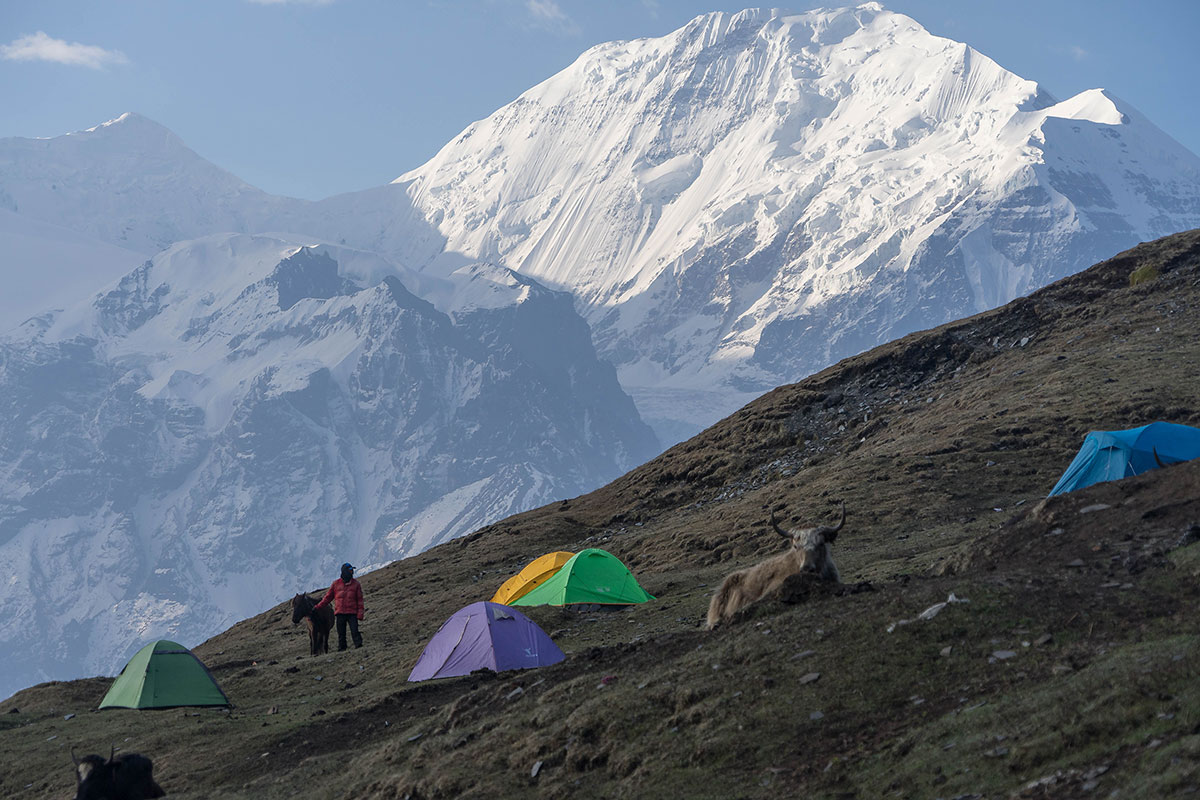
Nar Phu Annapurna Circuit Trek
17 Days
Trekking through remote villages steeped in Tibetan heritage and still following their ancient traditions of yak herding, harvesting wild herbs for medicinal purposes, and trading across the Tibetan border it will be like stepping back in time.
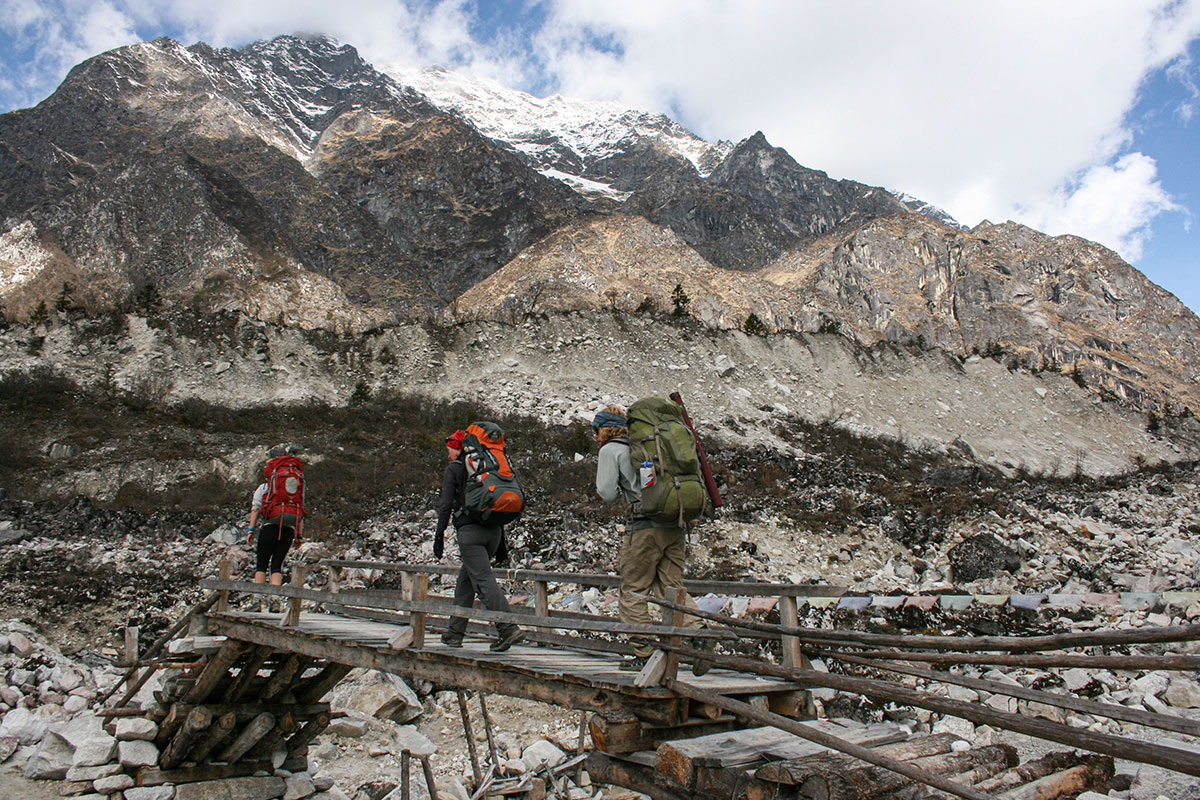
Tsum Valley Manaslu Circuit Trek
22 Days
Just as diverse as the ethnic population, so too the scenery varies from the lush, low elevation valleys growing rice and bananas, inhabited predominantly by the Hindu ethnic groups of Indo-Aryan origin, through rhododendron and bamboo forests, where you begin to encounter communities of Tibeto-Burmese origin who practice Hinduism, Buddhism or a mixture of both.
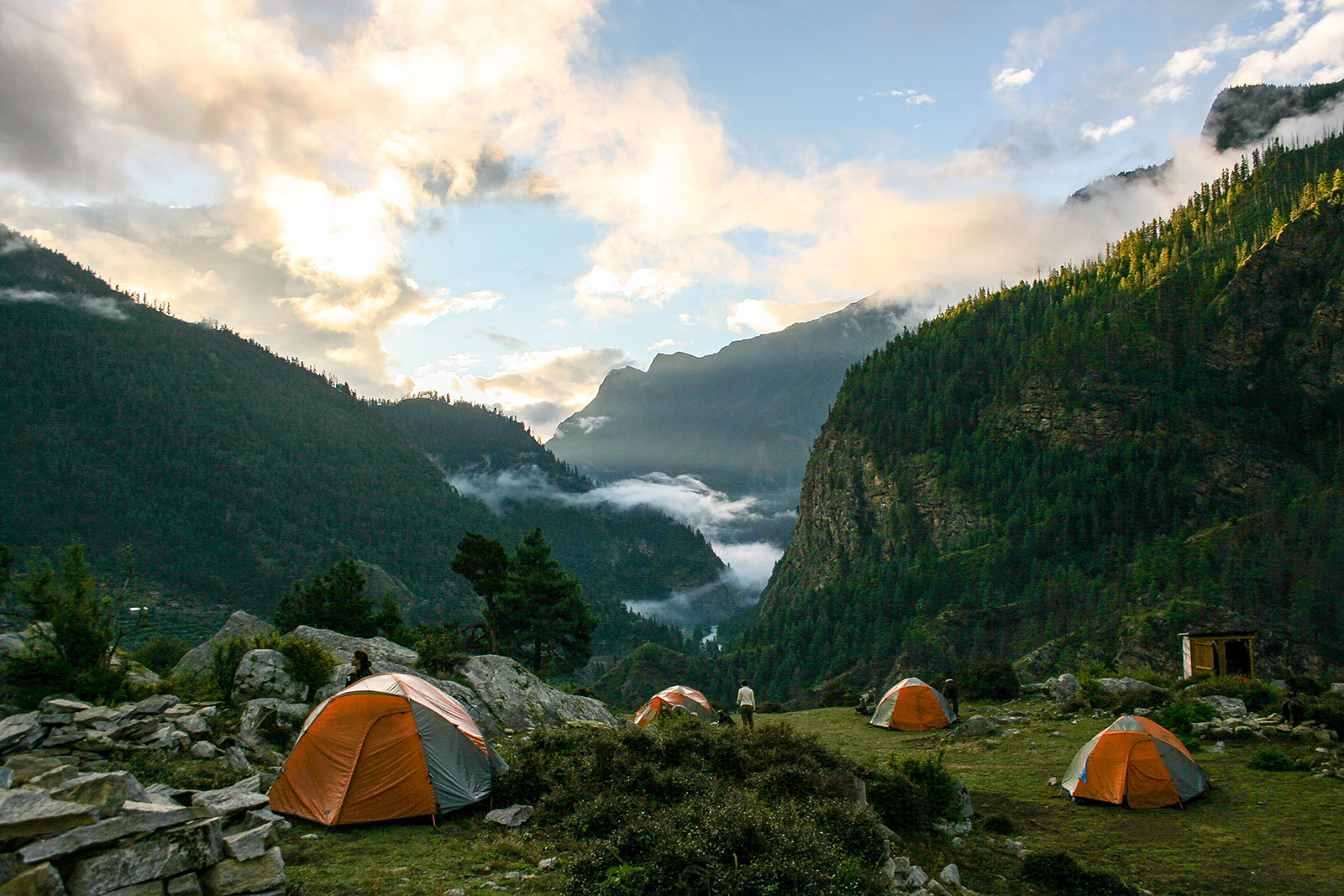
Humla Limi Valley Trek
20 Days
The Humla region of Nepal lies in the far west of the country and is so remote, that it has been out of reach for most visitors until very recently. Today it is one of the ultimate trekking dreams for hikers and those who wish to discover the unique natural and cultural landscape of Tibetan Buddhists.

NAR PHU ANNAPURNA CIRCUIT TREK
17 Days
Trekking through remote villages steeped in Tibetan heritage and still following their ancient traditions of yak herding, harvesting wild herbs for medicinal purposes, and trading across the Tibetan border it will be like stepping back in time.

TSUM VALLEY MANASLU CIRCUIT TREK
22 Days
Just as diverse as the ethnic population, so too the scenery varies from the lush, low elevation valleys growing rice and bananas, inhabited predominantly by the Hindu ethnic groups of Indo-Aryan origin, through rhododendron and bamboo forests, where you begin to encounter communities of Tibeto-Burmese origin who practice Hinduism, Buddhism or a mixture of both.

HUMLA LIMI VALLEY TREK
20 Days
The Humla region of Nepal lies in the far west of the country and is so remote, that it has been out of reach for most visitors until very recently. Today it is one of the ultimate trekking dreams for hikers and those who wish to discover the unique natural and cultural landscape of Tibetan Buddhists.
CONTACT US
Let us help you plan the trip of your dreams
Address
GPO Box: 8974 CPC 437
Kathmandu, Nepal.
Nepal Govt. Registration
11881/424 1134/066
Phone
Our Team
Diaries
Featured Trips
Bespoke For You
CONTACT US
Let us help you plan the trip of your dreams
Address
GPO Box: 8974 CPC 437
Kathmandu, Nepal.
Nepal Govt. Registration
11881/424 1134/066
info@himalayanquests.com
Phone
+977 9849 141067

